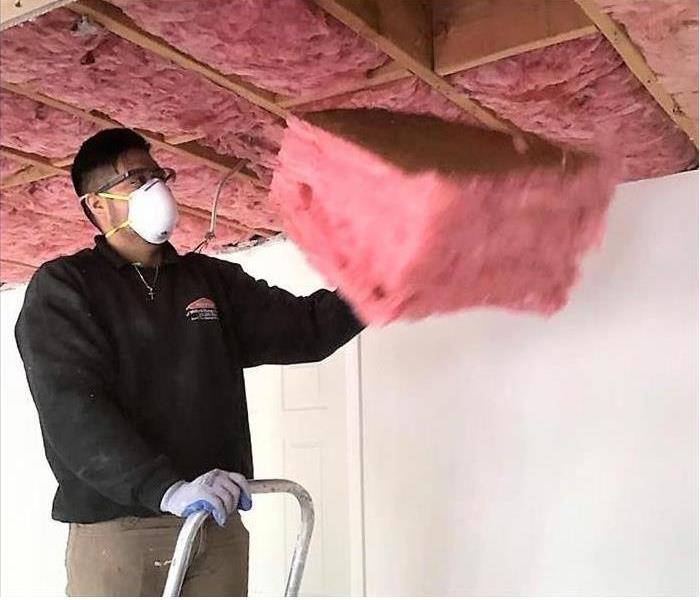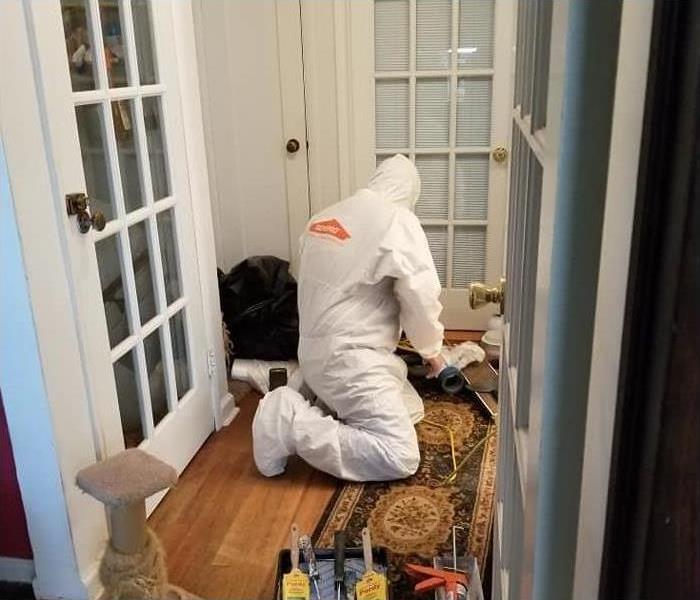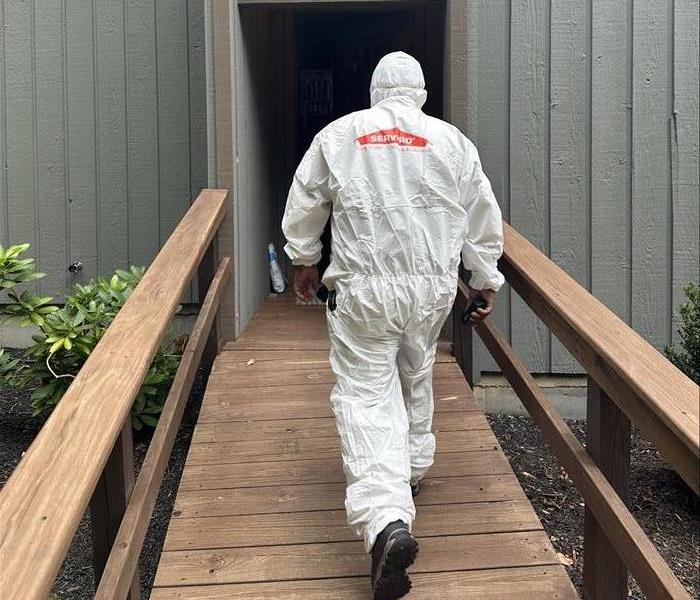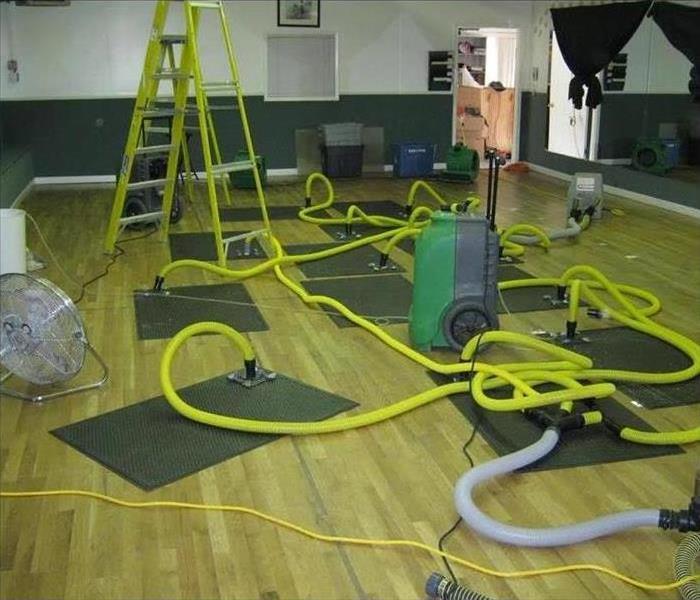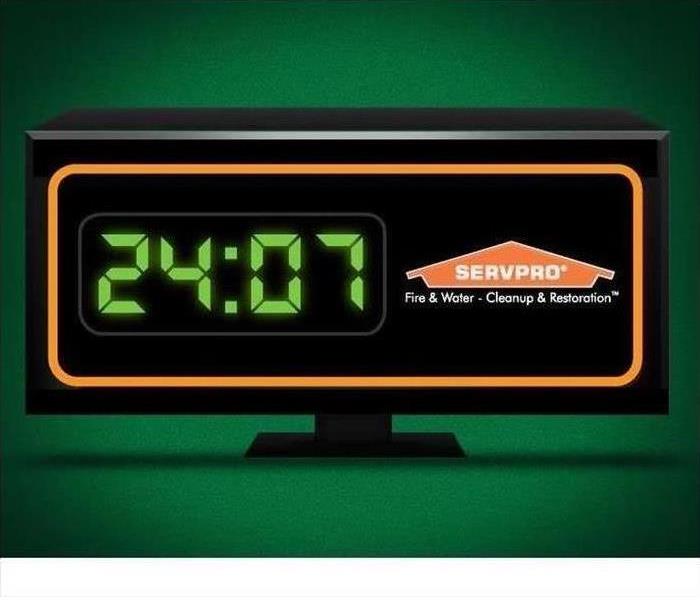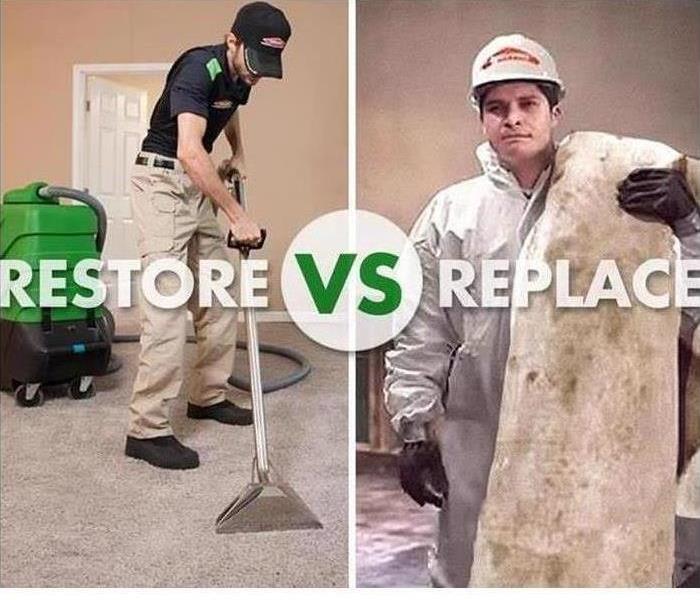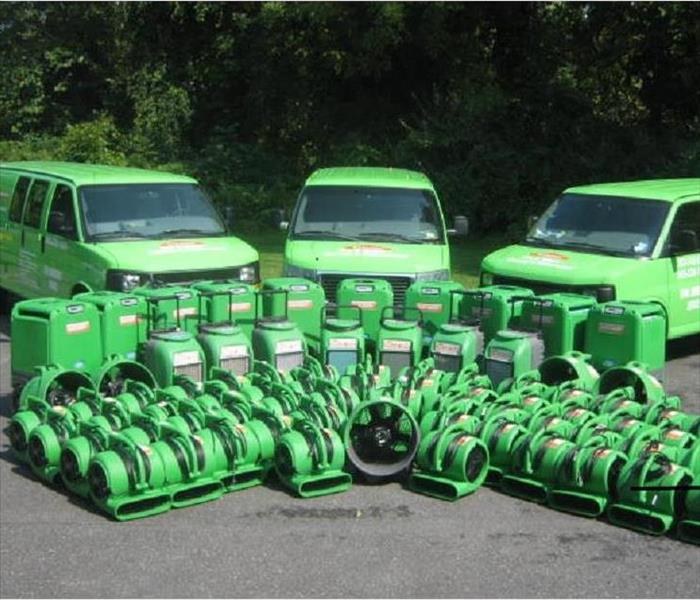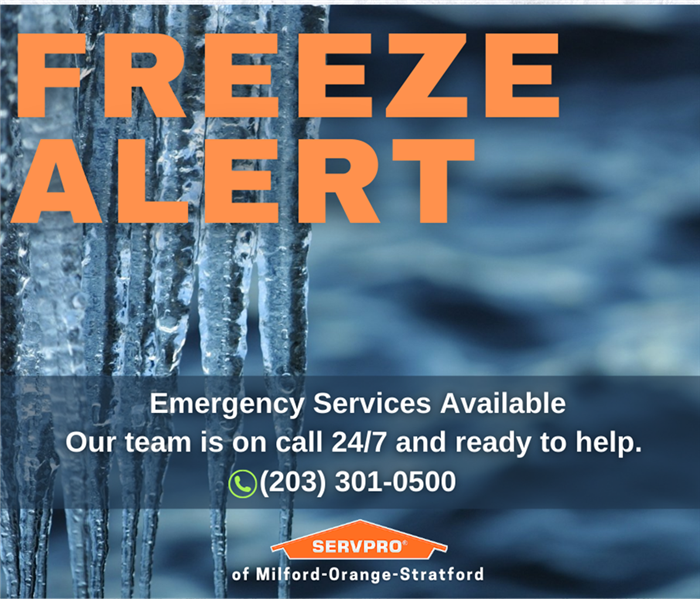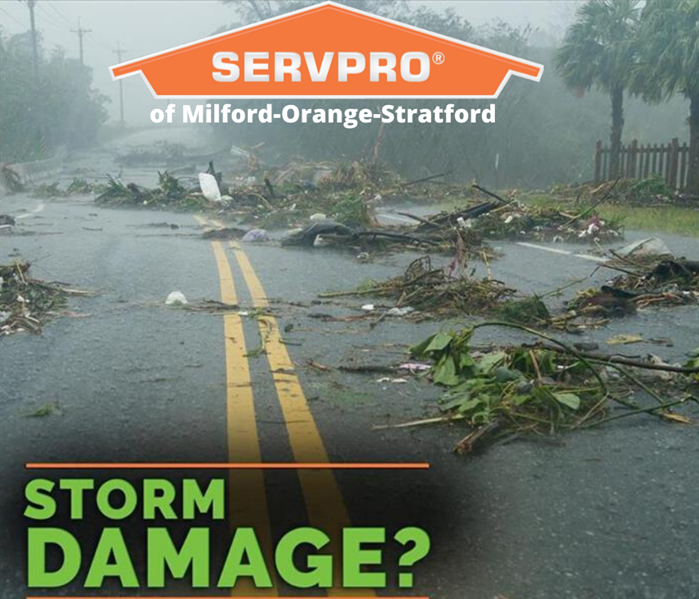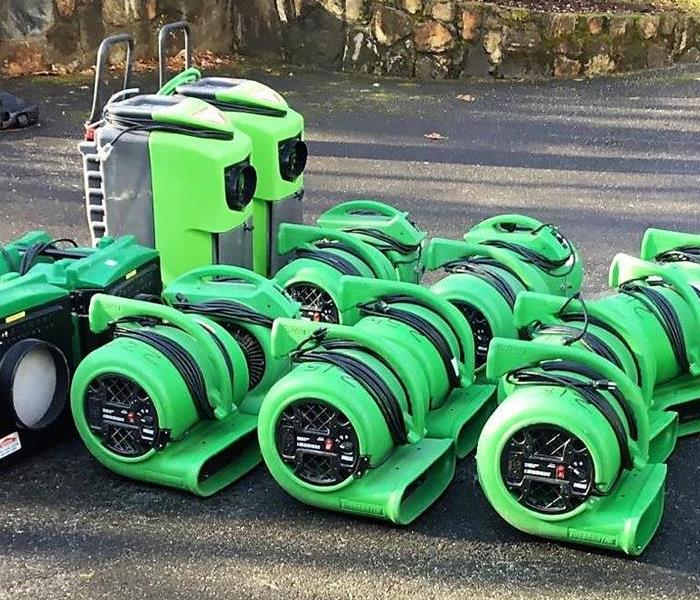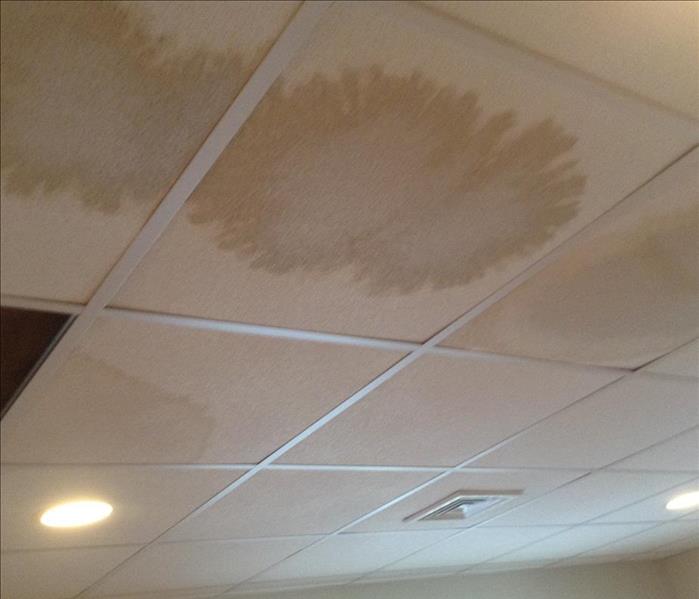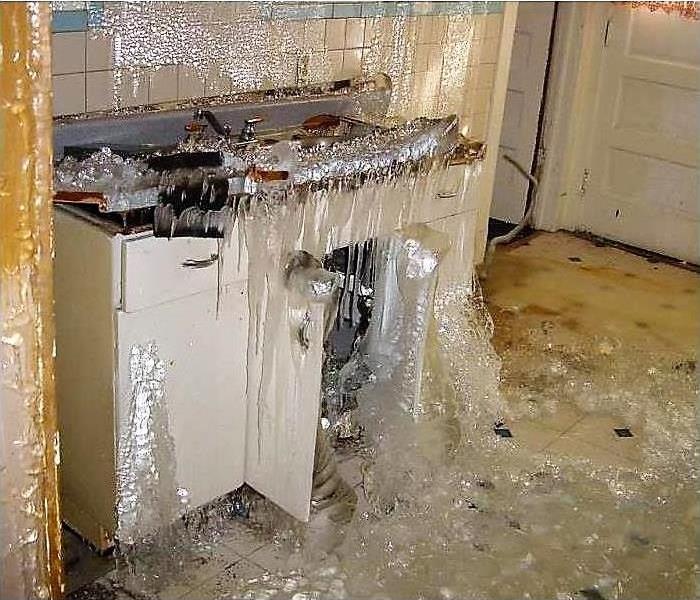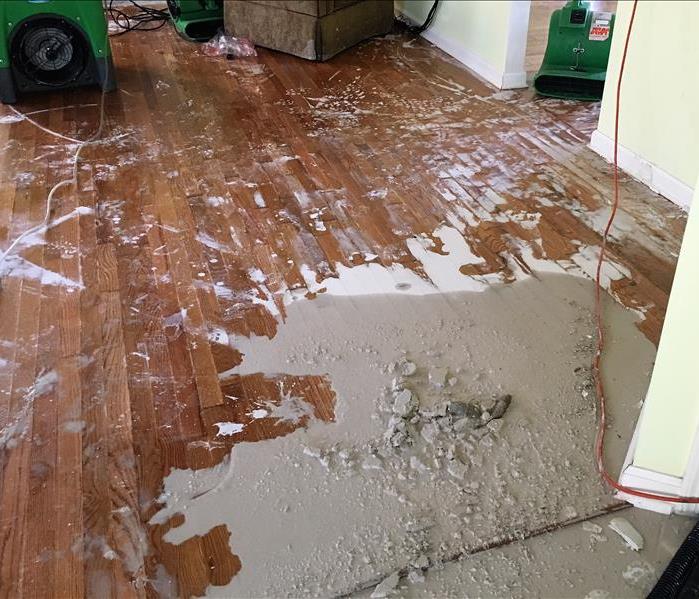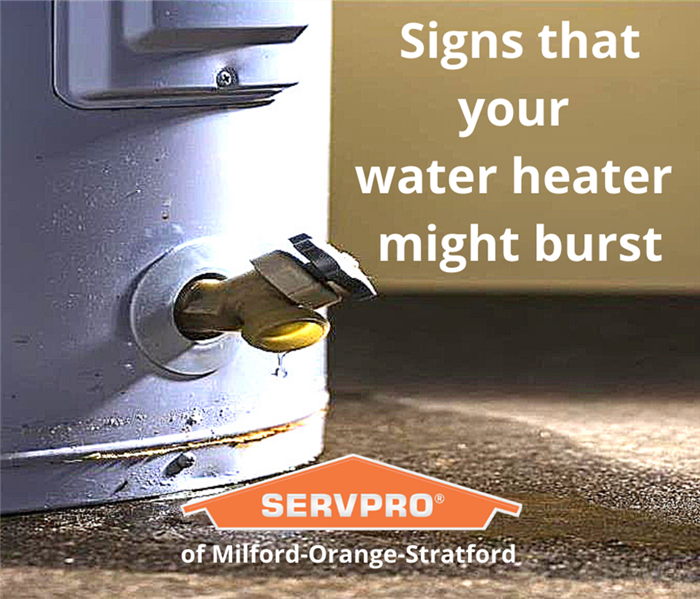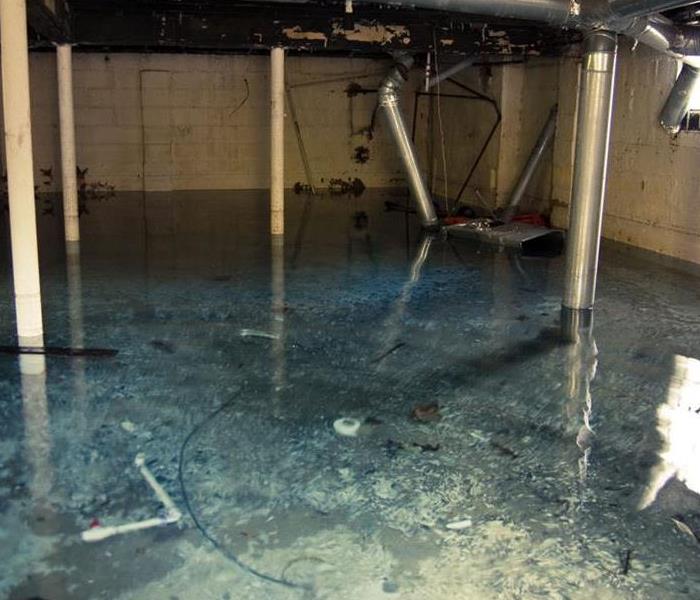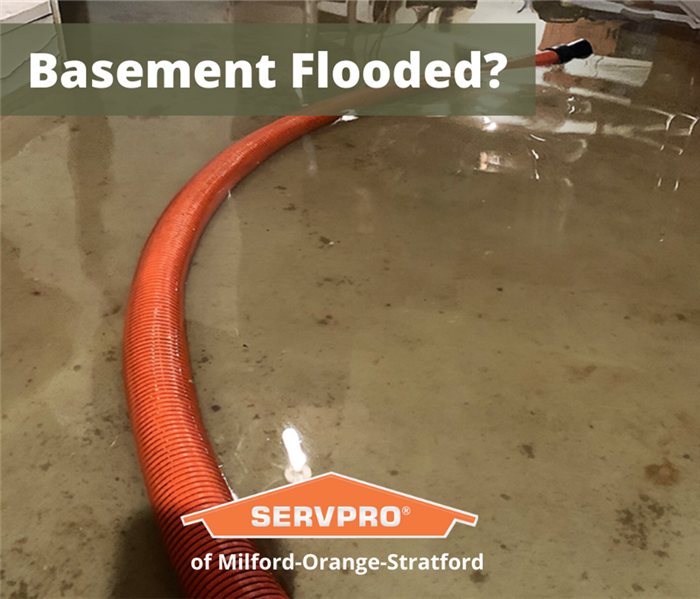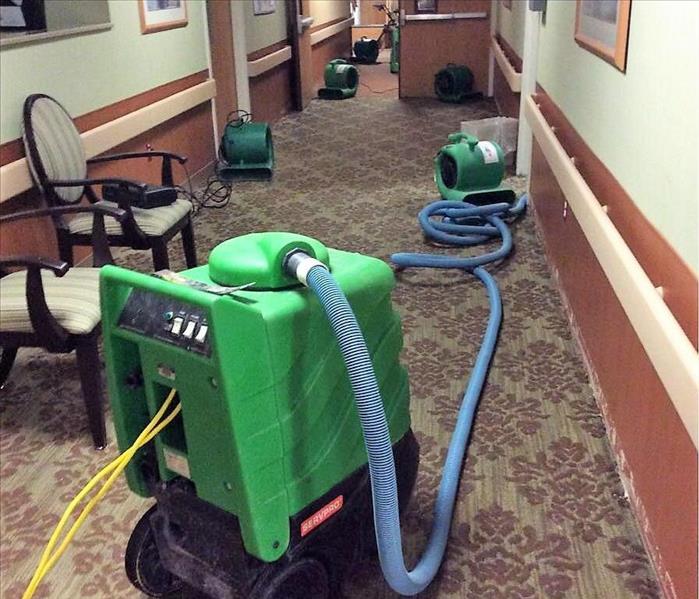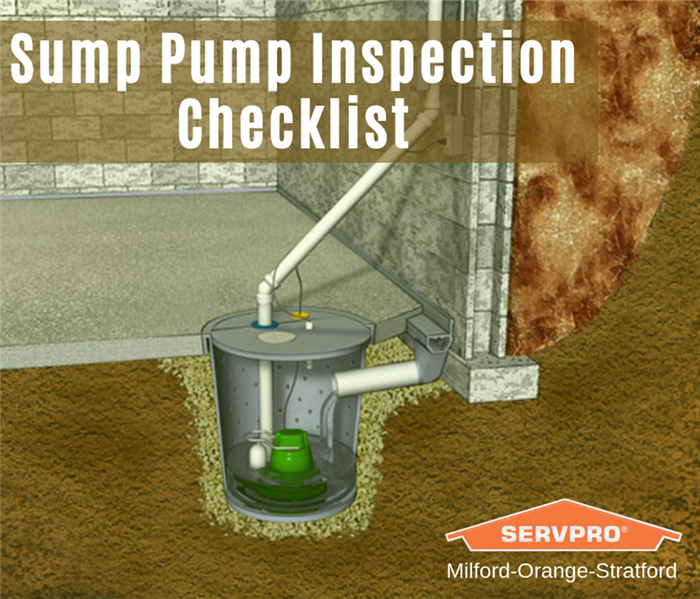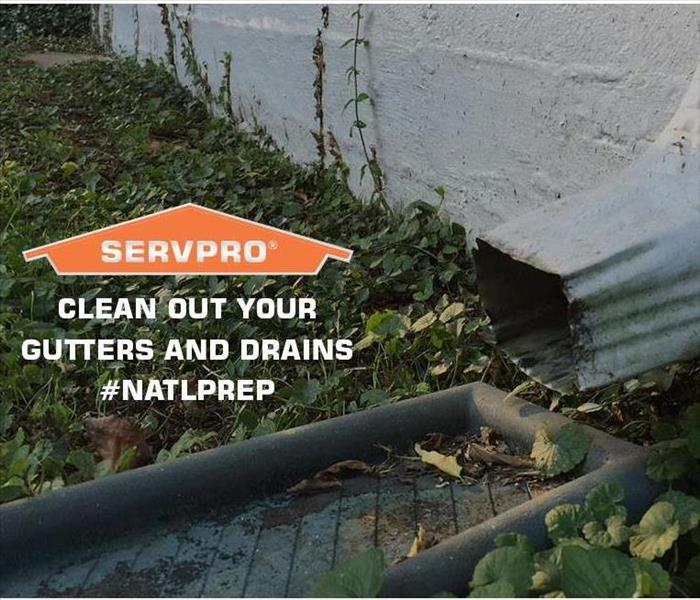Recent Water Damage Posts
Restoring Peace of Mind: Dealing with Water Damage
6/17/2024 (Permalink)
Imagine coming home to discover your house transformed into a watery disaster zone, courtesy of a burst pipe. It's a scenario that strikes fear into the hearts of homeowners everywhere. However, amidst the chaos and despair, there exists a beacon of hope: SERVPRO®, the trusted name in water damage restoration.
The Calamity: A Burst Pipe
The sudden rupture of a water pipe can turn a peaceful home into a scene of chaos within minutes. Whether due to aging infrastructure, extreme temperatures, or an unforeseen accident, a burst pipe unleashes gallons of water into places where it doesn't belong. From soaking carpets and furniture to seeping into walls and ceilings, the damage can be swift and extensive.
Initial Response: Navigating the Crisis
In such moments of crisis, quick action is crucial. The first steps involve shutting off the water supply to prevent further flooding and ensuring the safety of all occupants. Once these immediate concerns are addressed, the focus shifts to damage assessment and mitigation. Here's where SERVPRO steps in.
SERVPRO: The Restoration Experts
SERVPRO is not just a cleanup crew; we are a lifeline in times of water damage emergencies. With their expertise and experience, SERVPRO teams swiftly assess the extent of the damage. Our thorough inspection identifies areas affected by water intrusion, even those not immediately visible to the untrained eye.
The Restoration Process
Once the assessment is complete, our team formulates a comprehensive restoration plan tailored to each unique situation. This plan typically includes:
Water Extraction: Using powerful pumps and vacuums, SERVPRO extracts standing water from affected areas, minimizing further damage and mold growth.
Drying and Dehumidification: Industrial-grade air movers and dehumidifiers are deployed to remove moisture from floors, walls, and air spaces. This step is crucial in preventing secondary damage and mold formation.
Cleaning and Sanitizing: Salvageable belongings and structures are meticulously cleaned and sanitized to mitigate the effects of water damage and restore them to preloss conditions.
Restoration: Finally, our skilled technicians undertake repairs and reconstruction as necessary. This may involve replacing drywall, repairing structural damage, or restoring damaged surfaces like carpets and hardwood floors.
Beyond Restoration: Restoring Peace of Mind
While SERVPRO's primary mission is physical restoration, our impact goes beyond repairing walls and floors. We restore peace of mind to homeowners by handling the complexities of insurance claims and providing clear communication throughout the process. Our dedication to customer satisfaction ensures that homeowners can focus on rebuilding their lives with minimal disruption.
Turning the Tide: SERVPRO's Comprehensive Water Damage Restoration Services
5/20/2024 (Permalink)
Water damage can strike unexpectedly, wreaking havoc on homes and businesses alike. Whether it's from burst pipes, flooding, or leaky roofs, the aftermath of water damage can be overwhelming. However, amidst the chaos, there's a beacon of hope: SERVPRO of Milford-Orange-Stratford's water damage restoration services. In this blog post, we'll dive into how our expertise, efficiency, and compassion help restore properties and peace of mind in the wake of water damage disasters.
Understanding the Urgency:
When it comes to water damage, time is of the essence. The longer water sits, the greater the potential for structural damage, mold growth, and other costly issues. That's why SERVPRO® responds quickly to water damage emergencies, arriving on the scene promptly to assess the situation and begin mitigation efforts.
Assessment and Mitigation:
The first step in our water damage restoration process is a thorough assessment of the damage. Our trained technicians use advanced equipment to identify the source of the water intrusion, assess the extent of the damage, and develop a tailored mitigation plan. From water extraction and drying to dehumidification and odor removal, SERVPRO employs state-of-the-art techniques to mitigate further damage and restore affected areas.
Precision Drying and Dehumidification:
Effective drying and dehumidification are crucial steps in the water damage restoration process. SERVPRO utilizes industrial-grade drying equipment and moisture detection tools to remove excess moisture from the air and building materials. Our goal is to restore the affected property to pre-damage conditions as quickly and efficiently as possible, minimizing downtime and disruption for homeowners and businesses.
Mold Remediation and Prevention:
One of the biggest concerns associated with water damage is mold growth. Mold can begin to develop within 24-48 hours of water exposure, posing health risks and further complicating the restoration process. SERVPRO's mold remediation experts are trained to identify and remove mold colonies safely and effectively. Additionally, we take proactive measures to prevent future mold growth, ensuring a clean and healthy environment for occupants.
Restoration and Reconstruction:
Once the mitigation process is complete, SERVPRO shifts its focus to restoration and reconstruction. Our team works diligently to repair and rebuild damaged areas, from replacing flooring and drywall to restoring structural integrity. With a meticulous attention to detail and a commitment to quality craftsmanship, SERVPRO restores properties to their preloss condition, allowing homeowners and businesses to move forward with confidence.
Support and Guidance:
Throughout the water damage restoration process, SERVPRO provides more than just technical expertise – we offer support and guidance every step of the way. We understand the stress and uncertainty that come with water damage emergencies, and we're here to alleviate those burdens. From navigating insurance claims to coordinating with other contractors, SERVPRO serves as a trusted partner in the restoration journey.
When water damage strikes, SERVPRO is here to help turn the tide. With our comprehensive water damage restoration services, we mitigate damage, prevent further issues, and restore properties to their former glory. If you're facing water damage, don't hesitate to reach out to SERVPRO for prompt, professional assistance. Together, we'll weather the storm and emerge stronger on the other side.
Water Damage Restoration in a Home With Hoarding
8/24/2023 (Permalink)
Water damage from floodwater is considered a biohazardous situation, as the water can contain dangerous pathogens. When a home is a hoarding situation, the work becomes a bit more complicated, with several more layers of clean up involved.
In many hoarding situations, the floors and walls of the home cannot be accessed so its possible that there existed unnoticed water or mold damage prior to the flood.
The contents of the home need to be removed prior to the restoration work beginning. Our team always takes the upmost precautions when we work in such a home. Our crew wears protective gear to prevent exposure to pathogens and items must be disposed of properly. When the affected area is clear, we can better assess the situation and create a water damage restoration plan that we leave the home clean and safe for those who live there.
We understand that hoarding can be a delicate situation to address and our team approaches our work with empathy and consideration in such cases.
Hot Water Heater Bursts in Milford
8/22/2023 (Permalink)
No matter what the season, your hot water heater can give you a problem.
Although there are a number of reasons associated with a hot water heater failure, the most common cause that we see is due to old age. Hot water heaters will typically last you between 10-15 years. A leak may occur when corrosion and mineral build up occurs to the internal components. What may begin as a little leak can quickly lead to a flooded basement.
As a homeowner, knowing the signs that your hot water heater is on its last legs can help you avoid a water disaster.
- Water color/quality: When running your faucet on hot, note it’s appearance. If it appears rusty, this is a s sign that there might be corrosion in your tank and signals an upcoming failure of your water heater.
- Look for signs of muddy water or increased sediment in the water tank: Muddy water or increased sediment signals a potential failure of your water heater. You can check this by attaching a hose to the drainage bib on the water heater, turn the unit off and drain it to examine its contents. When flushing the water heater, remember that the water that comes out of the hose bib at the front of the water heater is going to be extremely hot, as it will not be mixed with cold water. Smell or taste the water. If the hot water has a metallic taste to it, this indicates that the water heater is close to breaking down.
- Listen to the noises your water tank makes: Your heater will normally make sounds however any loud cracks or pops could indicate a problem.
If you notice your hot water heater has any of the symptoms of a failure, call your plumber for an inspection.
For floods caused by hot water tank leaks, call SERVPRO of Milford-Orange-Stratford at (203) 301-0500 for immediate service.
When Your HVAC Causes Water Damage
8/8/2022 (Permalink)
Has an air conditioner leak causing water damage to your home?
Air conditioners are known to leak – whether from a dirty filter, a malfunctioning pump, a cracked drain pan or even a damaged evaporator coil. We’ve seen this cause significant water damage to New Haven area homes. It can soak sheetrock walls and ceilings as well as insulation and carpeting.
If you have flooding from an A/C leak, your first course of action is to shut the unit off and call your serviceman to identify and repair the problem. Then, call SERVPRO of Milford-Orange-Stratford to clean it up. When we receive your call, our office will send a team out to inspect the situation and immediately start the restoration work.
To treat water damage caused by air conditioning units, our treatment plan will likely include water extractors to remove any standing water as well as water that has soaked into carpets and upholstery. We also treat water damage events with air movers and dehumidifiers to remove the moisture out of the air and expedite the drying process. We use our floor mat extraction system to remove the moisture from wet wood and tile floors. This system utilizes a strong suction by use of mats, which are attached to a vacuum with hoses, allowing the vacuum to draw out moisture from underneath the floor.
Our services include the removal of any damaged and unsalvageable materials such as wet sheetrock, flooring and damaged baseboards. Our building services team is CT licensed to rebuild the damaged portions of your home. This might include repairing and painting walls, installing new flooring or even a complete rebuild of your home if necessary.
For more information on our water damage restoration services, please call our office at (203) 301-0500.
It's all in the timing.
7/14/2022 (Permalink)
How long will it take to dry out my house?
It's the question on everybody's mind when the SERVPRO team is called to your home after a water damage. And it seems like it should be an easy answer however there are a number of variables that can affect how quickly the restoration of your home will take.
When our team arrives at your home, we begin to document the cause of water damage, the extent of damage, and all surfaces involved. We then formulate a water damage restoration plan using a software program that is designed determine the number of air movers, air scrubbers and dehumidifiers are required to begin the drying process.
Of course, our team knows that there is more to this work than technical specs and we don't completely rely on a computer system. Our property managers utilize their decades of experience restoring homes and businesses after water damage in determining a treatment plan.
So, to answer the question - when will it be dry? On average, a typical house will be dry in about four days, depending on the extent of the damage. For example, vacant homes usually have more severe damage and mold may have begun to grow before the water damage was discovered, necessitating more extensive treatment.
We all want the restoration work to be done quickly and efficiently. Our crew works as a team to do the job right and allow you to go back to your normal routine as quickly as possible.
Your Carpets are Soaked - We Can Help.
3/28/2022 (Permalink)
What’s to be done about carpeting when you’ve had a flood in your home?
Water damage restoration is not a “one size fits all” solution and while it’s true that carpeting is unsalvageable in many situations, that’s not always the case.
How does our team overcome wet carpeting?
Our approach to carpet restoration and water extraction varies depending on the fiber count and thickness of the carpet itself, as short pile carpeting (glue down) absorbs less water than plusher options. The restoration of carpets requires a combination of several water removal tools exclusively designed for this porous flooring. Some of the devices and machines our team uses in this process include:
- Carpet Wands – The addition of specialty attachments like carpet wands to the wet vacuums and pumps already in use is a versatile implement to the extraction of water. These attachments are a focused vacuum head used on the surface of carpeting to pull the majority of moisture from the fibers and backing material.
- Weighted Extractors – When it is possible to restore the carpet, the padding, and the underlying material, it is critical to reduce their oversaturation quickly. The best approach for this is a weighted extraction option that utilizes a technician's weight on a stationary or ride-on unit. The heft of the machine and the operator press the carpet and padding against the subflooring to force moisture to the surface for removal.
- Floating – Once most of the moisture has been removed by weighted extraction, floating the carpet by placing a centrifugal air mover between the carpet and padding layers dry both materials simultaneously.
It's not always obvious which carpeting can be saved. For a professional assessment of your water damage situation, give us a call!
The Green Machines
3/8/2022 (Permalink)
Your Milford area business has had water damage. Perhaps a pipe has broken, a toilet overflowed or your coffee maker line sprung a leak.
You’ve called SERVPRO of Milford-Orange Stratford and have been assured that the crew is on their way to clean up the mess. After our property manager has inspected your property, work will begin based on their assessment. The crew will start to unload the trucks and begin work. While the bright green equipment is getting set up throughout your facility, you will likely wonder what all of it does.
When water damage occurs, we typically use the following equipment.
Air Mover and/or Axial Fans: Professional grade air movers and axial fans produce more air movement than a standard household fan. The higher volume of air being moved increases the rate of evaporation, helping to dry the structure as quickly as possible.
Dehumidifiers: A dehumidifier removes water vapor from the air by condensing it out against refrigerated fins. The water is stored and then periodically purged from the machine by use of plastic tubing. The tubing will generally be run so that it dumps water down a drain, such as a bath tub or sink, or sometimes out a window or door. Professional dehumidifiers pull much more vapor from the air than a household dehumidifier. In this way they are generally more efficient.
Air Scrubbers: An air scrubber might be used if your loss is a result of water classified as grey or black, which means that it came from a contaminated source or through building materials. These machines remove airborne particulates by trapping them in HEPA filters. Air Scrubbers are also used in cases where a customer has a health condition that requires the air quality be monitored.
Specialty Drying Equipment: There are a variety of different tools available to our technicians for use in specialty circumstances. For instance, a floor drying mat system allows the technician to create a vacuum system for removing moisture from hardwood floors, in order to try to dry them in place. This helps the floor dry faster, and generally gives us a better chance of saving the hardwood flooring.
If you have any questions about the equipment being used during the restoration of your commercial property, our crew chiefs and technicians are always available to explain the process and what the function of each of those machines in your building is.
We understand that our customers are not experts in water damage restoration. When you have water damage, we are here to help restore your property quickly and efficiently.
What Causes Water Damage in Milford Homes?
2/17/2022 (Permalink)
As a homeowner, you are at risk of experiencing water damage in your house.
This is true regardless of whether your house is old or new, big or small, in the country or in the city. From supply line leaks to bathtub overflows to frozen pipes, our water damage restoration team has seen it all here in New Haven County.
These are the most common causes of residential water damage that SERVPRO of Milford-Orange-Stratford responds to.
Water Heater Leaks
Usually located in the basement, a water heater leak can be an especially damaging event because it is not always immediately discovered. Water heater failures occur for a variety of reasons. Often, the leak is caused by a loose or faulty drain valve. Inspecting your heater’s valves and tightening them if needed is an easy way to avoid disaster. As water heaters age, they can corrode and rust, causing degradation to the tank. This can cause your water heater to leak and flood your basement.
Clogged Pipes
Clogged pipes can occur due to several reasons but the result is eventually the same- water damage. Keep a lookout for the signs of a clogged pipe such as reduced water pressure. Look for small leaks from your pipes as well as mildew, mold and water stains on walls. If water drains slowly in your sinks or shower, that is a sign that your pipes are partially clogged. If you hear gurgling sounds when there is no water running through your pipes, that may indicate a clogged sewer line. Educate your family on what items should be disposed of in your toilet to avoid a toilet clog. If you have a septic system, the regular use of enzymes in your toilet and shower drains can help keep them clear.
Household Appliance Malfunctions
We have seen water damage from all household appliances-especially refrigerators, dishwashers and washing machines. This can occur from a supply line leak – although the line is often small, the water that runs through it is unlimited. Supply lines can deteriorate and fail with age but we’ve even seen new lines break, so keep an eye behind your appliances for potential issues. Replacing rubber hoses with braided stainless steel ones will reduce your risk of a supply line leak. Washing machines can leak due to a water pump failure and broken door seals, gaskets and latches. Regular maintenance of your washing machine is recommended.
Frozen Pipes
In Connecticut, frozen pipes are a common event and keep our crews busy through the winter months. Pipes usually freeze because the home or area of a home such as a sunroom is inadequately heated. The pipes are forced to expand due to the frozen water, causing the pipe to crack. When the temperature warms up, the water flows freely through the cracks, causing massive damage. If you lose heat to your home due to a power outage during a snowstorm, feel your pipes to make sure they aren't freezing and use an alternative heat source if available.
Wet Basements
On the Connecticut shoreline, basements are inherently damp. They are prone to flooding, and are the home to pipes that may leak. If you have high levels of moisture in your basement, install a dehumidifier to dry it out. Make sure that the ground around your home is graded away to reduce flooding. Check your foundation for any cracks that may be allowing water in and seal them up. Broken gutters that are not properly directing the water away from the house can also contribute to basement flooding.
Sump Pump Failure
A sump pump can be a life saver if you have a wet basement but if it fails, you can have major water damage. If your sump pump fails to operate, whether due to a power failure, or malfunction, the groundwater level around the foundation can rise to the point that it flows up and out of the sump onto the basement floor. Take the time to inspect your sump part regularly and check your basement if you have a power outage.
Prompt action is the number one thing a homeowner can do if they have water damage. The sooner the restoration process begins, the less work that will need to be done. SERVPRO of Milford-Orange-Stratford is New Haven County’s water restoration experts. Our team is highly trained and experienced. Call our office at (203) 301-0500 if your home is flooded with water.
Wintertime Hazards in Milford, CT
1/25/2022 (Permalink)
Snowstorms are followed closely by our team here at SERVPRO of Milford-Orange-Stratford. A strong nor'easter can cause trees and their limbs to fall. When a tree limb falls on a home, it often causes damage to the roof and allows snow and water to enter the home. Our crew provides emergency board up services to prevent further water damage. Our restoration team restores local homes and businesses from water damage that results as well.
High winds and the weight of snow and ice on the limbs can causes a tree to fall on a power line. This can cause a power outage that will result in the loss of heat for many homes as well. With oil burners and electrical heat sources not functioning, homes are at risk of pipes freezing and bursting. This can cause widespread water damage. A crack of only 1/8 of an inch will allow 250 gallons of water to flood out in just one day! Water from burst pipes can cause substantial damage including the collapse of ceilings and walls in a home.
It is extremely important that a qualified restoration service be called as soon as possible to clean up the water and damaged materials. Quick action can allow us to save more of your belongings and prevent secondary issues, such as mold.
Be prepared for the coming snowstorms this winter! Have an emergency supply kit ready and keep our number - (203) 301-0500 - on hand in case you have storm damage to your New Haven County home.
Water Damage Checklist: Protecting Your Home BEFORE Disaster Strikes
8/9/2021 (Permalink)
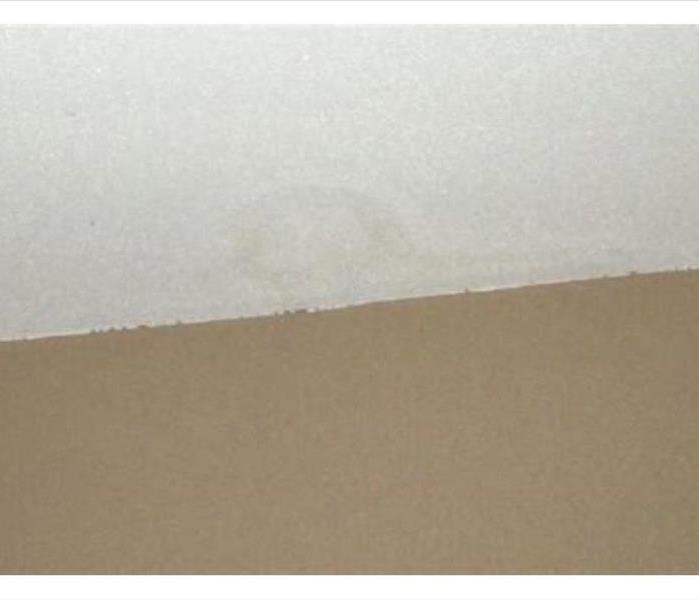 Even a small stain on your ceiling can be an indicator of a big problem.
Even a small stain on your ceiling can be an indicator of a big problem.
Life is busy and we all go about our days without a thought of potential water damage to our homes. And usually, there is nothing of concern going on however an occasional check of your home can prevent water and mold damage from becoming a big problem.
Here are some things to look out for:
Check your floors.
If you have wood floors, look for any warping, discoloration or buckling. Tiles might crack or have mildew on the caulk. Look for buckling or cracked linoleum, which can allow water to seep to the sub-floor. Carpets with water damage are easy to identify- they will be wet and have a musty smell.
2. Look for Stains
Water stains are a big clue that there is a leaking pipe. Stains on ceilings and walls are some of the most obvious signs of water damage. Also look for cracks and peeling paint in drywall. As the drywall gets saturated, paint can lose adhesion.
3. Take a walk around the outside
In particular, focus on your gutters and drainage. Do you see any pools of water or areas of erosion? Any of those issues could threaten the foundation of your house. Also check your roof for any broken shingles or distorted flashing.
By discovering any potential water damage problems sooner than later, you can avoid costly damage to your home.
It's Hurricane Season in Connecticut- Are You Prepared?
7/19/2021 (Permalink)
It’s just August and we’ve already experienced our first tropical storm which caused significant wind and water damage here in the New Haven area.
With a few more months of hurricane season ahead of us, take the time now to prepare for the next storm.
Before the Hurricane:
- Create or Replenish Your Emergency Kit. Ready.gov recommends these items for every household.
- Find out whether your property is flood-prone due to its elevation level and consider flood insurance if you are at risk.
- Store copies of important documents, such as proof of ownership of any property and identification, as well as insurance policy information in your emergency kit.
- Back up the data on your electronic devices to ensure it’s secure if your computer or other devices are damaged during the hurricane.
Get your property ready:
- Secure your roof. Check your roof for any loose shingles
- Maintain gutters and downspouts. Clean your gutters and downspouts regularly to prevent clogs.
- Secure your windows. For homes in CT, Installing plywood is a good temporary protection for your windows.
- Trim trees and shrubs. Loose branches in your yard (and neighborhood) could be struck by powerful winds during a storm, damaging your house.
- Secure loose objects. Your yard may also host objects that could become projectiles in high winds. Bring loose objects such as potted plants and lawn furniture inside and tie down larger items- such as trampolines and swingsets.
- Charge your cell phone to have a full battery if the power goes out.
- Turn your refrigerator to the coldest setting so that food lasts longer during a power outage.
- Take a trip to the gas station and fill up your cars as well as emergency fuel for your generator.
After the Hurricane
- Be cautious of floodwater: it may also can contain contaminants, dangerous debris or downed power lines.
- Contact your insurance company for assistance and take pictures of damaged property.
- Don’t touch wet electrical equipment
- Throw out food that has been exposed to floodwaters or have not been maintained at a proper temperature. When in doubt, throw it out.
- Don’t drink tap water if you’re not sure it’s safe.
SERVPRO of Milford-Orange-Stratford specializes in storm damage clean-up.
Our 24 hour Emergency Services Team is ready to come board up or tarp up your damaged home or business. From water damage restoration to rebuilding your home after the storm, we are THE team to call after a hurricane damages your home.
The Green Machines and What They Do.
4/15/2021 (Permalink)
Your Milford area business has had water damage. Perhaps a pipe has broken, a toilet overflowed or your coffee maker line sprung a leak.
You’ve called SERVPRO of Milford-Orange Stratford and have been assured that the crew is on their way to clean up the mess. After our property manager has inspected your property, work will begin based on their assessment. The crew will start to unload the trucks and begin work. While the bright green equipment is getting set up throughout your facility, you will likely wonder what all of it does.
When water damage occurs, we typically use the following equipment.
Air Mover and/or Axial Fans: Professional grade air movers and axial fans produce more air movement than a standard household fan. The higher volume of air being moved increases the rate of evaporation, helping to dry the structure as quickly as possible.
Dehumidifiers: A dehumidifier removes water vapor from the air by condensing it out against refrigerated fins. The water is stored and then periodically purged from the machine by use of plastic tubing. The tubing will generally be run so that it dumps water down a drain, such as a bath tub or sink, or sometimes out a window or door. Professional dehumidifiers pull much more vapor from the air than a household dehumidifier. In this way they are generally more efficient.
Air Scrubbers: An air scrubber might be used if your loss is a result of water classified as grey or black, which means that it came from a contaminated source or through building materials. These machines remove airborne particulates by trapping them in HEPA filters. Air Scrubbers are also used in cases where a customer has a health condition that requires the air quality be monitored.
Specialty Drying Equipment: There are a variety of different tools available to our technicians for use in specialty circumstances. For instance, a floor drying mat system allows the technician to create a vacuum system for removing moisture from hardwood floors, in order to try to dry them in place. This helps the floor dry faster, and generally gives us a better chance of saving the hardwood flooring.
If you have any questions about the equipment being used during the restoration of your commercial property, our crew chiefs and technicians are always available to explain the process and what the function of each of those machines in your building is.
We understand that our customers are not experts in water damage restoration. When you have water damage, we are here to help restore your property quickly and efficiently.
Got Spots?
3/23/2021 (Permalink)
Many homeowners turn a blind eye when they spot a yellow stain on their ceiling. I don’t know what we are thinking when we do this - clearly the spot was caused by a leak of some sort and isn’t going to disappear.
The old adage “bad news doesn’t get better with age” comes to mind here.
We can avoid the problem by averting our eyes away from the spots on the ceiling, however the problem will likely get worse the longer it is ignored.
Ceiling stains are typically caused by a few common scenarios.
- Leaks - Even a small leak can eventually cause water damage and mold. The leak usually occurs directly above the ceiling stain. An overflowing bathtub, leaky washing machine hose or broken toilet is often the culprit. Old caulking can allow water to leak onto the floor as well. Leaky pipes also create water spots. It’s common for water to run along rafters or damaged pipes and drop onto the ceiling. This causes the pooling of water in that spot.
- Ice Dam Leakage: When stains appear at ceiling corners or outside walls, the most probable cause is ice dam leakage We’ve also seen cases where the water from ice dams has made its way across the ceiling. A good way to see if your attic is not sufficiently insulated is to inspect the nail heads for condensation. If they are rusted or their sheathing is stained, condensation is the issue.
- Condensation: Sometimes, the connection between an exhaust pipe and roof cap is not airtight and moisture that should be released outside condenses wildly at the joint. The water slides down to the duct bottom and falls right back out of the exhaust pipe. Water damage from condensation can also occur when an air duct is not properly insulated.
We know that you want to ignore the problem but doing so won’t make it go away. And if you read our blogs regularly, you know that denial can lead to further water damage and mold growth.
So, take your head out of the sand and figure out what is causing that spot! In many cases, ceiling stains are caused by easily remedied problems and if addressed immediately, will cause little disruption to your life.
SERVPRO of Milford-Orange-Stratford Teams are on the Road
3/1/2021 (Permalink)
The unprecedented cold front that hit Texas last week caused power outages across the state. The number of unheated homes in which water pipes froze and burst is staggering. There was simply too much widespread damage and not enough help.
Due to our decades of experience restoring homes and businesses with burst pipes, the SERVPRO of Milford-Orange-Stratford team was called in to help. We have several crews working down south to help displaced families get back in their homes. (But don't worry, we continue to be staffed and ready to help our home community in Connecticut). Many of the homes are flooded, with ceilings that have collapsed and water dripping everywhere. We know how devastating this is and treat our customers and their homes with the upmost respect while we restore them.
Winter storms and frozen pipes are a way of life here in the Milford area. Our team is trained, equipped and here to help when, and where, we are needed.
Winter Storm Causes Damage to New Haven County Homes
2/2/2021 (Permalink)
Snowstorms are followed closely by our team here at SERVPRO of Milford-Orange-Stratford. A strong nor'easter can cause trees and their limbs to fall. When a tree limb falls on a home, it often causes damage to the roof and allows snow and water to enter the home. Our crew provides emergency board up services to prevent further water damage. Our restoration team restores local homes and businesses from water damage that results as well.
High winds and the weight of snow and ice on the limbs can causes a tree to fall on a power line. This can cause a power outage that will result in the loss of heat for many homes as well. With oil burners and electrical heat sources not functioning, homes are at risk of pipes freezing and bursting. This can cause widespread water damage. A crack of only 1/8 of an inch will allow 250 gallons of water to flood out in just one day! Water from burst pipes can cause substantial damage including the collapse of ceilings and walls in a home.
It is extremely important that a qualified restoration service be called as soon as possible to clean up the water and damaged materials. Quick action can allow us to save more of your belongings and prevent secondary issues, such as mold.
Be prepared for the coming snowstorms this winter! Have an emergency supply kit ready and keep our number - (203) 301-0500 - on hand in case you have storm damage to your New Haven County home.
Is Your Water Heater at Risk of Bursting?
9/28/2020 (Permalink)
No matter what the season, your hot water heater can give you a problem.
Although there are a number of reasons associated with a hot water heater failure, the most common cause that we see is due to old age. Hot water heaters will typically last you between 10-15 years. A leak may occur when corrosion and mineral build up occurs to the internal components. What may begin as a little leak can quickly lead to a flooded basement.
As a homeowner, knowing the signs that your hot water heater is on its last legs can help you avoid a water disaster.
- Water color/quality: When running your faucet on hot, note it’s appearance. If it appears rusty, this is a s sign that there might be corrosion in your tank and signals an upcoming failure of your water heater.
- Look for signs of muddy water or increased sediment in the water tank: Muddy water or increased sediment signals a potential failure of your water heater. You can check this by attaching a hose to the drainage bib on the water heater, turn the unit off and drain it to examine its contents. When flushing the water heater, remember that the water that comes out of the hose bib at the front of the water heater is going to be extremely hot, as it will not be mixed with cold water. Smell or taste the water. If the hot water has a metallic taste to it, this indicates that the water heater is close to breaking down.
- Listen to the noises your water tank makes: Your heater will normally make sounds however any loud cracks or pops could indicate a problem.
If you notice your hot water heater has any of the symptoms of a failure, call your plumber for an inspection.
For floods caused by hot water tank leaks, call SERVPRO of Milford-Orange-Stratford at (203) 301-0500 for immediate service.
Hurricane Season is Here
8/11/2020 (Permalink)
It’s just August and we’ve already experienced our first tropical storm which caused significant wind damage here in the New Haven area.
It caught many of us off-guard and we weren’t prepared for the power outages (how many of us still working from home were affected by the loss of internet and cell service?)
With a few more months of hurricane season ahead of us, take the time now to prepare for the next storm.
Before the Hurricane:
- Create or Replenish Your Emergency Kit. Ready.gov recommends these items for every household.
- Find out whether your property is flood-prone due to its elevation level and consider flood insurance if you are at risk.
- Store copies of important documents, such as proof of ownership of any property and identification, as well as insurance policy information in your emergency kit.
- Back up the data on your electronic devices to ensure it’s secure if your computer or other devices are damaged during the hurricane.
Get your property ready:
- Secure your roof. Check your roof for any loose shingles
- Maintain gutters and downspouts. Clean your gutters and downspouts regularly to prevent clogs.
- Secure your windows. For homes in CT, Installing plywood is a good temporary protection for your windows.
- Trim trees and shrubs. Loose branches in your yard (and neighborhood) could be struck by powerful winds during a storm, damaging your house.
- Secure loose objects. Your yard may also host objects that could become projectiles in high winds. Bring loose objects such as potted plants and lawn furniture inside and tie down larger items- such as trampolines and swingsets.
- Charge your cell phone to have a full battery if the power goes out.
- Turn your refrigerator to the coldest setting so that food lasts longer during a power outage.
- Take a trip to the gas station and fill up your cars as well as emergency fuel for your generator.
After the Hurricane
- Be cautious of floodwater: it may also can contain contaminants, dangerous debris or downed power lines.
- Contact your insurance company for assistance and take pictures of damaged property.
- Don’t touch wet electrical equipment
- Throw out food that has been exposed to floodwaters or have not been maintained at a proper temperature. When in doubt, throw it out.
- Don’t drink tap water if you’re not sure it’s safe.
SERVPRO of Milford-Orange-Stratford specializes in storm damage clean-up.
Our 24 hour Emergency Services Team is ready to come board up or tarp up your damaged home or business. From water damage restoration to rebuilding your home after the storm, we are THE team to call after a hurricane damages your home.
Calls for Help with Wet Basements are Flooding In
4/21/2020 (Permalink)
A basement can flood at any time, although flooding most often occurs during heavy rainfall. Basements are inherently prone to flooding because they are the lowest level of a building and are normally built partly or entirely below ground level. There are a number of reasons why your Woodbridge, CT basement could flood, including:
- A blocked or failed sewer lateral pipe
- Heavy rain causes surface water to pool around your home
- Storm sewer backup
- Sanitary sewer backup
- Foundation drainage failure
- Water supply-line break or hot-water tank failure
If flood water is not handled quickly and properly, it can jeopardize your health and safety, and cause severe damage to your home’s structure. Remember, the longer you wait, the worse the problem will get.
The bottom line: a flooded basement can jeopardize your health, safety, and your home’s integrity. It’s worth making a call to SERVPRO of Milford-Orange-Stratford and let our trained, professional crews handle the situation safely and correctly. We have earned the trust of hundreds of homeowners, business owners, and property professionals.
We are Flooded Basement Specialists:
- We are Available 24 hours/7 days per week
- We’re a Preferred Vendor to many National Insurance Companies
- We Bill The Insurance Directly – One Less Thing For You To Worry About
- Our Technicians are Highly-Trained in Water Restoration Techniques
- We use s500 IICRC Restoration Standards
- Advanced Inspection and Extraction Equipment
Yes, We're Open and Safely Restoring New Haven County Homes After Water Damage
4/1/2020 (Permalink)
The Covid-19 pandemic has caused most of our lives to halt to a stop. Despite this, home and business owners still face many of the same challenges that existed prior to this outbreak. Dishwashers malfunction, roofs leak and basements flood just like before.
We are all concerned about spreading the coronavirus and some of our friends and customers have expressed concern over having people in their homes and businesses. Yet, water damage must be addressed quickly. Please be assured that our crew is practicing the highest level of safety as they work, for their own protection as well as yours. Some of the practices our franchise is adhering to strictly are:
- Personal Protection Equipment: Our crew is wearing gloves and masks on every job
- Social Distancing: We are following social distancing guidelines and maintaining a safe distance from each other as well as those who must remain in the building as we work
- Disinfecting: We are wiping down surfaces that we touch - such as doorknobs and light switches - with SERVPROxide, a hospital grade disinfectant. When deemed necessary, we are also applying the same disinfectant with a fogger in order to further sanitize.
Why can't you just wait for a few weeks until things go back to normal?
Unfortunately, the more time that goes by with untreated damage, the worse the situation gets.
The First 24 Hours:
- Drywall, which is found on the walls and ceilings of most Connecticut homes, gets saturated and begins to disintegrate. Many people discover their water leak only after the ceiling is already on the floor. That's how quickly this can happen.
- You will notice a musty smell and normal household odors grow stronger.
- Any uncoated metal surfaces, which are vulnerable to moisture in the air, will begin to tarnish.
- Your furniture may begin to show signs of damage. In particular, laminated furniture and flooring will begin to swell and crack due to the moisture.
- Free-floating laminated flooring may also begin to pop out of place due to swelling.
48 Hours to 1 Week:
- The 'clean water' situation will have been upgraded to a 'gray water' intrusion.
- You will notice an earthy smell in the home, which is caused by standing water as well as building materials and contents that have begun to decay.
- Because of the high moisture levels, fungi, mold and mildew will begin to grow at this time, especially on porous materials such as sheetrock and carpeting.
- Wood building materials begin to show signs of damage as they swell, warp and split. You will notice this on window frames, wall moldings, the interior doors in your home and even studs and joists at this time.
- Rust and corrosion will begin to occur on metal items.
- Electronics in the home will begin to malfunction.
- Wood flooring and furniture begin to swell from the saturation.
- The Indoor Air Quality in the structure is compromised and health hazards can become an issue. Occupants of the home who are at risk due to health issues may begin to experience negative health effects.
More Than 1 Week:
- A 'black water' situation is most likely the case at this time due to the growth of bacteria and other harmful contaminates in the home.
- Mold spores will spread quickly and begin to break down natural materials, wallpaper, wood paneling, and other building materials
- The structural safety of the home is in question as wood building materials are compromised.
- The air quality in the home can pose a danger to all inhabitants.
- The costs associated with your insurance claim exponentially rises. The demolition and replacement of, rather than the restoration of, damaged materials becomes necessary.
- Our water damage restoration crews will be required to wear personal protection equipment in order to work in your home.
With Spring Showers Comes Basement Flooding. We Can Help.
3/3/2020 (Permalink)
Boy, does it feel like spring today in Woodbridge!
It was a mild winter this year and unless a big surprise is on it’s way, it looks like it’s coming to an end. It’s at this time of year that our restoration team switches gears from “frozen pipes” to “flooded basements”. Basement flooding can occur at any time, but we see it especially in the spring, when snow melts and spring storms begin.
When we get a call about a flooded basement, we always advise that the homeowner shuts off the electrical supply to the basement (if it’s safe to do so) as well as the main water supply if the water is caused by a burst pipe. With floodwaters, it’s always possible that the water is contaminated and for that reason, wearing protective clothing is a smart precaution to take. Calling your insurance company immediately is recommended. If you have a sump pump installed, wait for it to drain the floodwater. If the pump has a backup battery, it should drain the water even if the power is off. If all of this seems overwhelming, our team is quick to respond and will be at your home quickly to mitigate the water damage.
How can you reduce your risk of basement flooding?
- In the fall, clean your gutters and downspouts and make sure that they will divert any rainwater at least six feet away from the house. The ground around your home should slope away from the structure.
- Install a sump pump that automatically drains water from your basement and prevents water from rising. Choose one with a backup battery.
- Seal openings or cracks in the walls, floors, foundations, and windows of your house.
- Install porous pavement around your home to help absorb rainwater and thawed snow.
- Ensure that your drainage systems and plumbing are working properly. Have them checked periodically by a professional.
Bad News Doesn't Get Better with Age - Resolve Your Ceiling Stain Problem Now to Avoid Further Damage
2/6/2020 (Permalink)
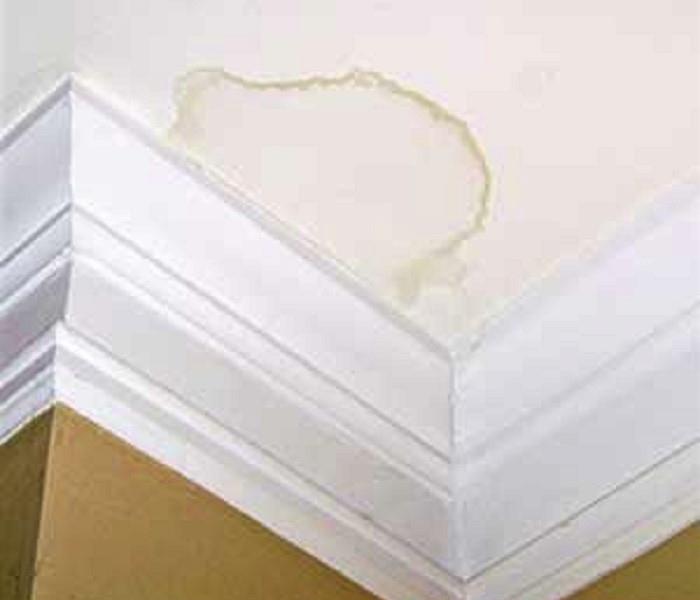 It's a small ceiling stain that you might want to ignore - but dealing with it now will save you a lot of trouble later!
It's a small ceiling stain that you might want to ignore - but dealing with it now will save you a lot of trouble later!
Many homeowners turn a blind eye when they spot a yellow stain on their ceiling. I don’t know what we are thinking when we do this - clearly the spot was caused by a leak of some sort and isn’t going to disappear.
The old adage “bad news doesn’t get better with age” comes to mind here.
We can avoid the problem by averting our eyes away from the spots on the ceiling, however the problem will likely get worse the longer it is ignored.
Ceiling stains are typically caused by a few common scenarios.
- Leaks - Even a small leak can eventually cause water damage and mold. The leak usually occurs directly above the ceiling stain. An overflowing bathtub, leaky washing machine hose or broken toilet is often the culprit. Old caulking can allow water to leak onto the floor as well. Leaky pipes also create water spots. It’s common for water to run along rafters or damaged pipes and drop onto the ceiling. This causes the pooling of water in that spot.
- Ice Dam Leakage: When stains appear at ceiling corners or outside walls, the most probable cause is ice dam leakage We’ve also seen cases where the water from ice dams has made its way across the ceiling. A good way to see if your attic is not sufficiently insulated is to inspect the nail heads for condensation. If they are rusted or their sheathing is stained, condensation is the issue.
- Condensation: Sometimes, the connection between an exhaust pipe and roof cap is not airtight and moisture that should be released outside condenses wildly at the joint. The water slides down to the duct bottom and falls right back out of the exhaust pipe. Water damage from condensation can also occur when an air duct is not properly insulated.
We know that you want to ignore the problem but doing so won’t make it go away. And if you read our blogs regularly, you know that denial can lead to further water damage and mold growth.
So, take your head out of the sand and figure out what is causing that spot! In many cases, ceiling stains are caused by easily remedied problems and if addressed immediately, will cause little disruption to your life.
Question From a Customer: Is Water Damage Covered Under My Homeowner's Insurance Policy?
9/30/2019 (Permalink)
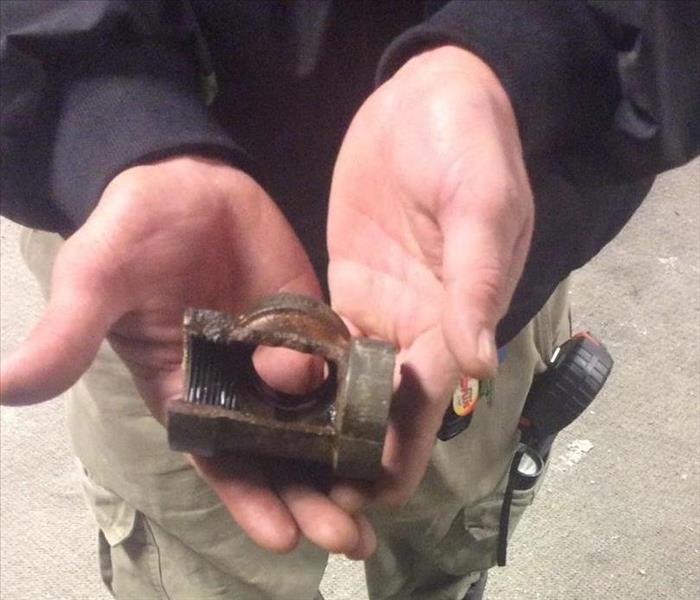 Broken pipe? Water damage from this is usually covered under most homeowners insurance policies.
Broken pipe? Water damage from this is usually covered under most homeowners insurance policies.
Water damage is the most common insurance claim in Connecticut households.
One of the most common questions we receive when we answer a call from a homeowner who has water damage is whether their insurance policy will cover it. Although coverage differs from policy to policy, most standard home owner's policies have similar coverage terms.
One rule of thumb is that if the water damage occurs suddenly and is accidental, it is typically covered. For example, if your hot water heater bursts and causes water damage or if your refrigerator line leaks, it will normally be covered. Other water damage scenarios that are usually covered are:
- Accidental overflows of the toilet, sink or bathtub
- Burst pipes
- Refrigerator, dishwasher or washing machine supply line leak
- Roof leaks
- Ice dams
- Water damage from extinguishing a fire
- Rain damage (the usual rule of thumb is if it doesn't hit the ground first- this would fall under the "flooding" category)
- Mold caused by water damage
A failure to properly maintain your plumbing and appliances may cause coverage to be denied. If you ignore that leaky sink to the point that it has rotted out your sub-floor, it may not be covered. So be careful to keep your home maintained.
In our experience, flooding from groundwater is typically NOT included under standard home insurance policies. Flooding is considered to be water that comes from a natural source- such as the rain, a river or a lake. Ground seepage is also not covered. So, if your basement floods after a heavy rainstorm, your insurance will not cover it. If you live near a river that tends to flood or on the Long Island Sound, you may want to consider purchasing flood insurance for your home. Flood insurance is offered through government programs, usually the National Flood Insurance Program.
Thankfully, most of the water damage cases that we see in the New Haven area are covered by insurance.
Kathy, our office manager, and Alexis and Theny, our admins, have years of experience assisting customers with their homeowner's insurance claims. When they take your call, they will help guide you every step of the way. Our staff works directly with your insurance company, submitting paperwork and photographs required. If the contents of your home are damaged, our crew will help you sort through the items, taking an inventory of belongings that can be restored, saved or discarded.
Water damage is never a welcome sight however our team strives to make your experience as streamlined and hassle free as possible.
Air Conditioner Leaks Cause Water Damage to New Haven Area Homes
8/20/2019 (Permalink)
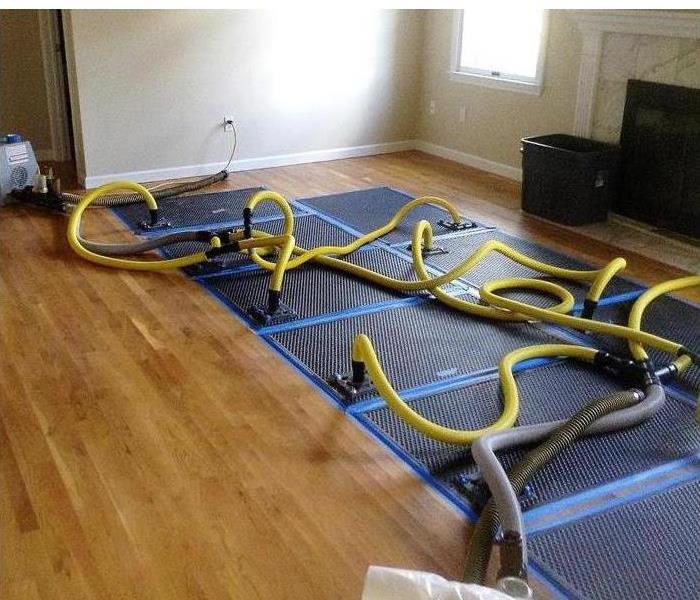 Our floor mat system effectively removes moisture from wood floors, saving them after water damage from air conditioner leaks.
Our floor mat system effectively removes moisture from wood floors, saving them after water damage from air conditioner leaks.
Has an air conditioner leak causing water damage to your home?
Air conditioners are known to leak – whether from a dirty filter, a malfunctioning pump, a cracked drain pan or even a damaged evaporator coil. We’ve seen this cause significant water damage to New Haven area homes. It can soak sheetrock walls and ceilings as well as insulation and carpeting.
If you have flooding from an A/C leak, your first course of action is to shut the unit off and call your serviceman to identify and repair the problem. Then, call SERVPRO of Milford-Orange-Stratford to clean it up. When we receive your call, our office will send a team out to inspect the situation and immediately start the restoration work.
To treat water damage caused by air conditioning units, our treatment plan will likely include water extractors to remove any standing water as well as water that has soaked into carpets and upholstery. We also treat water damage events with air movers and dehumidifiers to remove the moisture out of the air and expedite the drying process. We use our floor mat extraction system to remove the moisture from wet wood and tile floors. This system utilizes a strong suction by use of mats, which are attached to a vacuum with hoses, allowing the vacuum to draw out moisture from underneath the floor.
Our services include the removal of any damaged and unsalvageable materials such as wet sheetrock, flooring and damaged baseboards. Our building services team is CT licensed to rebuild the damaged portions of your home. This might include repairing and painting walls, installing new flooring or even a complete rebuild of your home if necessary.
For more information on our water damage restoration services, please call our office at (203) 301-0500.
The Equipment that SERVPRO of Milford-Orange-Stratford Uses During Commercial Water Damage Restoration
6/10/2019 (Permalink)
Your Milford area business has had water damage. Perhaps a pipe has broken, a toilet overflowed or your coffee maker line sprung a leak.
You’ve called SERVPRO of Milford-Orange Stratford and have been assured that the crew is on their way to clean up the mess. After our property manager has inspected your property, work will begin based on their assessment. The crew will start to unload the trucks and begin work. While the bright green equipment is getting set up throughout your facility, you will likely wonder what all of it does.
When water damage occurs, we typically use the following equipment.
Air Mover and/or Axial Fans: Professional grade air movers and axial fans produce more air movement than a standard household fan. The higher volume of air being moved increases the rate of evaporation, helping to dry the structure as quickly as possible.
Dehumidifiers: A dehumidifier removes water vapor from the air by condensing it out against refrigerated fins. The water is stored and then periodically purged from the machine by use of plastic tubing. The tubing will generally be run so that it dumps water down a drain, such as a bath tub or sink, or sometimes out a window or door. Professional dehumidifiers pull much more vapor from the air than a household dehumidifier. In this way they are generally more efficient.
Air Scrubbers: An air scrubber might be used if your loss is a result of water classified as grey or black, which means that it came from a contaminated source or through building materials. These machines remove airborne particulates by trapping them in HEPA filters. Air Scrubbers are also used in cases where a customer has a health condition that requires the air quality be monitored.
Specialty Drying Equipment: There are a variety of different tools available to our technicians for use in specialty circumstances. For instance, a floor drying mat system allows the technician to create a vacuum system for removing moisture from hardwood floors, in order to try to dry them in place. This helps the floor dry faster, and generally gives us a better chance of saving the hardwood flooring.
If you have any questions about the equipment being used during the restoration of your commercial property, our crew chiefs and technicians are always available to explain the process and what the function of each of those machines in your building is.
We understand that our customers are not experts in water damage restoration. When you have water damage, we are here to help restore your property quickly and efficiently.
Ways to Tell if Your Hot Water Heater Might Burst
4/22/2019 (Permalink)
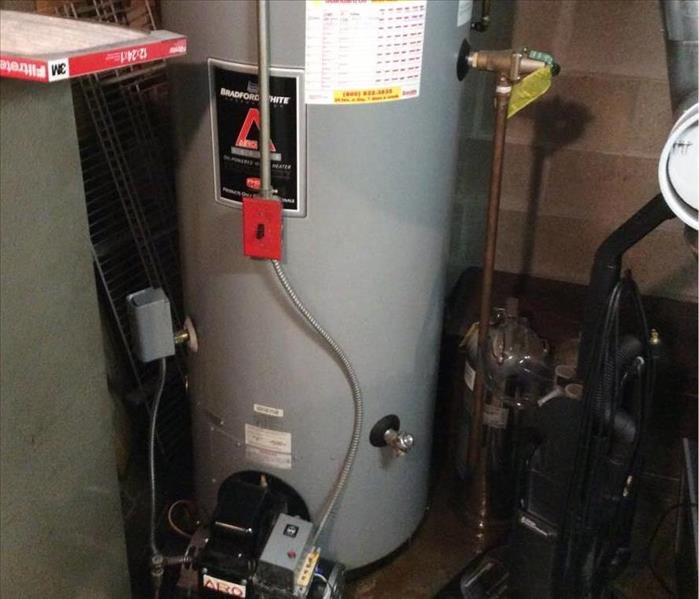 A hot water heater failure in this Trumbull home caused damage to the finished basement
A hot water heater failure in this Trumbull home caused damage to the finished basement
No matter what the season, your hot water heater can give you a problem.
Although there are a number of reasons associated with a hot water heater failure, the most common cause that we see is due to old age. Hot water heaters will typically last you between 10-15 years. A leak may occur when corrosion and mineral build up occurs to the internal components. What may begin as a little leak can quickly lead to a flooded basement.
As a homeowner, knowing the signs that your hot water heater is on its last legs can help you avoid a water disaster.
- Water color/quality: When running your faucet on hot, note it’s appearance. If it appears rusty, this is a s sign that there might be corrosion in your tank and signals an upcoming failure of your water heater.
- Look for signs of muddy water or increased sediment in the water tank: Muddy water or increased sediment signals a potential failure of your water heater. You can check this by attaching a hose to the drainage bib on the water heater, turn the unit off and drain it to examine its contents. When flushing the water heater, remember that the water that comes out of the hose bib at the front of the water heater is going to be extremely hot, as it will not be mixed with cold water. Smell or taste the water. If the hot water has a metallic taste to it, this indicates that the water heater is close to breaking down.
- Listen to the noises your water tank makes: Your heater will normally make sounds however any loud cracks or pops could indicate a problem.
If you notice your hot water heater has any of the symptoms of a failure, call your plumber for an inspection.
For floods caused by hot water tank leaks, call SERVPRO of Milford-Orange-Stratford at (203) 301-0500 for immediate service.
DIY: Inspect Your Sump Pump to Avoid Water Damage
4/1/2019 (Permalink)
It’s not uncommon for New Haven County homes to have a sump pump installed to keep a basement dry.
The function of a sump pump is to ensure that the water drains properly and reduce the risk of water damage. It’s important to make sure that your sump pump is in good working order with an annual inspection that can be done by most homeowners on their own.
SUMP PUMP INSPECTION CHECKLIST
- Check the power source for the pump. It should connect to a ground fault circuit interruptor (GFCI) for maximum safety. Inspect the cord to the pump, looking for evidence of wear and tear.
- Find the outlet pipe that allows the water to drain outside of your home. Make sure that there aren't any clogs or damages done to the drain making it impossible for water to exit the home and flow away from the foundation.
- Make sure the pump is level and upright. When it runs, the vibrations from the motor or the force of the water can cause it to tilt, which will let the float shift out of place.
- Locate the sump pump in the lower level of your home and check the inside of it to ensure that the pump is not clogged with debris.
- Take the pump out of the basin. At the bottom, there should be a grate, which needs cleaned of any debris that could cause a malfunction.
- Slowly pour approximately 5 gallons of water into the pump to simulate if a storm were to hit. As you pour, watch for it to turn on and start pumping the water out of your home. If should start pumping when the water reaches about 8-12 inches below the basement floor. This task simply assures you that the pump will run when it needs to and that nothing has malfunctioned.
- If your sump pump contains a float in the basin, make sure that it is also functioning properly and not caught on anything while running the test. This float is what lets the sump pump know when the water reaches a certain height and activates the pump.
Most sump pumps work with no issues however we do receive calls from those unlucky homeowners that experience a failure and have a flooded basement.
If your sump pump fails, give SERVPRO of Milford-Orange-Stratford a call at (203) 301-0500.
Spring is Just Around the Corner in New Haven County!
3/5/2019 (Permalink)
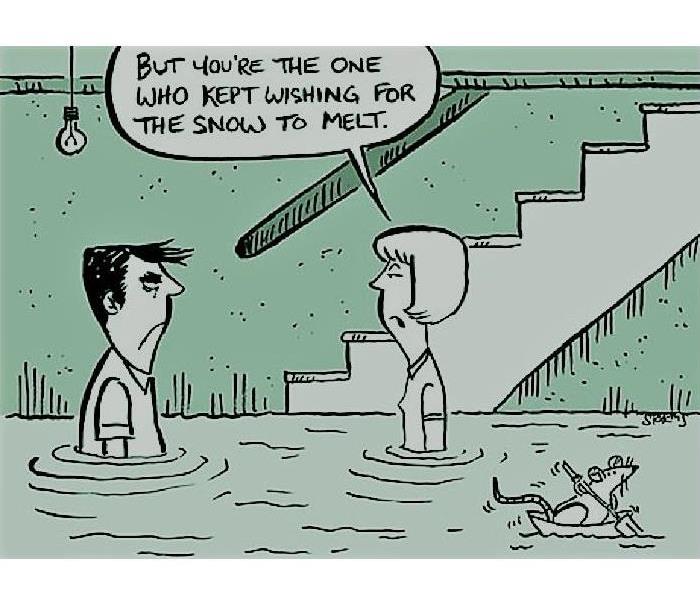 We are all looking forward to springtime in Connecticut but the warm temperatures can mean basement flooding to homes and businesses.
We are all looking forward to springtime in Connecticut but the warm temperatures can mean basement flooding to homes and businesses.
Trust us. Despite the snow that fell this week in the Woodbridge, CT area, spring really is just around the corner.
The shining sun outside today is giving us all a little hope and if you are like us, you are ready for this winter to end! Between the single digit temps, heavy snow, several thaws and heavy rain, we’ve worked for months mitigating water damage and flooding from frozen pipes and ice dams. As a water damage restoration company, we know that the coming of spring does not mean an end to water damage in area homes and businesses.
Warm temperatures thaw the ground, creating a soggy, uneven surface. When the snow melts, puddles form and the ground becomes so saturated that flooding occurs. In particular, we see quite a bit of basement flooding in March and April due to water seeping through leaks and cracks in the foundation. Basement damage can happen quick and can be unexpected - occurring even in a basement that has previously remained dry. Unless you keep your basement empty, the flooding will not only cause structural damage, but also cause damage to your belongings. In addition, basement flooding can create the ideal environment for mold and mildew growth.
So what’s a homeowner to do to avoid water damage during the spring thaw?
There are a few steps that you can take to reduce your risk of flooding.
Ice Damming
Ice dams are not only a concern during the winter months. Because ice dams are a problem when the weather warms and the ice melts, they are troublesome during the early spring. Careful removal of snow off of your roof with a roof rake after snow falls (and hopefully when it is still light and fluffy!) will prevent ice dams from forming and causing water damage inside your home.
Melting Snow
The best way to keep melting snow from making its way into your basement is to grade the ground closest to your foundation. Build up the soil in order to have at least a six-inch slope from the foundation to at least ten feet from the property to keep water from seeping into the foundation or basement.
Clogged Gutters
Clogged gutters can cause water to spill over the side, down the walls of your home and seep into the foundation. Make sure your gutters are free of debris to ensure proper water flow. Properly install downspouts and extenders to direct runoff away from your home. Because your gutters are your first line of defense, houses without, or with clogged, gutters often have leakage problems caused by water splashing against the foundation. You can also dig a plastic lined trench to divert the runoff from the roofline.
As we all look forward to the warmer months, keep in mind that we aren't in the clear yet from water damage!
If you do have flooding from melting snow, call our office at (203) 301-0500 for immediate water damage restoration services.
From 0 to 50 - Freezing Temperatures Give Way to Rain, Causing Flooding in Milford Homes and Businesses
1/28/2019 (Permalink)
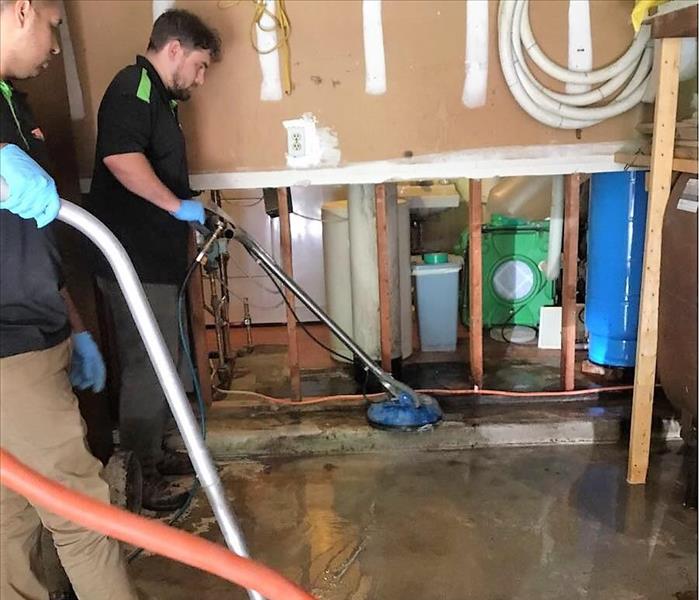 Freezing temps followed by a 50 degree increase and rain will lead to burst pipes and flooded basements in New Haven County.
Freezing temps followed by a 50 degree increase and rain will lead to burst pipes and flooded basements in New Haven County.
Last week was quite a wild weather ride.
New Haven area thermometers were in the single digits over the weekend and then soared up to the 50's and an inch of rain just a few days later. These weather events caused water damage in homes and businesses to local Milford homes and businesses.
Our office received dozens of calls from residents who had flooding in their homes. There were two main causes of water damage that our crew responded to.
The low temperatures caused pipes to freeze and burst in vulnerable areas such as garages, exterior walls and poorly insulated rooms. When the weather warmed up, massive amounts of water began to flow through the crack in the pipe, causing flooding to the home.
Once the heavy rains came on Thursday, we began receiving calls from homeowners who had flooding in their basements. With an inch of rain, and the ground still frozen and unable to absorb much water, groundwater quickly seeped into basements and caused flooding.
When crazy weather strikes, SERVPRO of Milford-Orange-Stratford is ready to clean it up and restore your home. Call us at (203) 301-0500 if you experience flooding in your home or business.
Avoid Basement Floods With Proper Sump Pump Maintenance
8/28/2018 (Permalink)
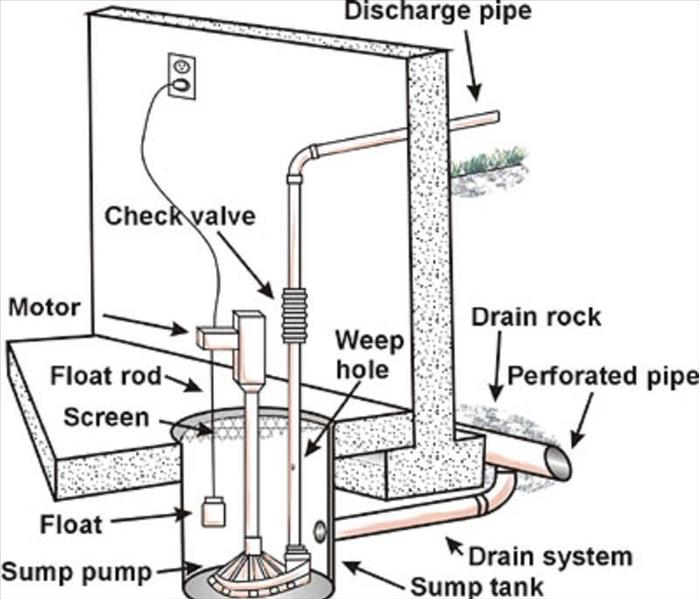 Properly maintaining our sump pump can help you avoid flooding in the basement of your Milford, CT home or business
Properly maintaining our sump pump can help you avoid flooding in the basement of your Milford, CT home or business
Many of our customers have a sump pump installed in the basement of their New Haven County home to keep it dry. Sump pumps ensure that the water drains properly and does not collect in your home, causing water damage. If you maintain your sump pump, it should perform it's job and you will forget that it is there. However, If you neglect your sump pump, a failure can happen, resulting in water damage and a big mess. Inspecting a sump pump is a task that a homeowner can do on their own. We recommend doing an annual inspection.
- Check the power source for the pump. It should connect to a ground fault circuit interruptor (GFCI) for maximum safety. Inspect the cord to the pump, looking for evidence of wear and tear.
- Find the outlet pipe that allows the water to drain outside of your home. Make sure that there aren't any clogs or damages done to the drain making it impossible for water to exit the home and flow away from the foundation.
- Make sure the pump is level and upright. When it runs, the vibrations from the motor or the force of the water can cause it to tilt, which will let the float shift out of place.
- Locate the sump pump in the lower level of your home and check the inside of it to ensure that the pump is not clogged with debris.
- Take the pump out of the basin. At the bottom, there should be a grate, which needs cleaned of any debris that could cause a malfunction.
- Slowly pour approximately 5 gallons of water into the pump to simulate if a storm were to hit. As you pour, watch for it to turn on and start pumping the water out of your home. If should start pumping when the water reaches about 8-12 inches below the basement floor. This task simply assures you that the pump will run when it needs to and that nothing has malfunctioned.
- If your sump pump contains a float in the basin, make sure that it is also functioning properly and not caught on anything while running the test. This float is what lets the sump pump know when the water reaches a certain height and activates the pump.
Most sump pumps work with no issues however we do receive calls from those unlucky homeowners that experience a failure and have a flooded basement. If your sump pump fails, give SERVPRO of Milford-Orange-Stratford a call at (203) 301-0500.
The Top Causes of Residential Water Damage
8/6/2018 (Permalink)
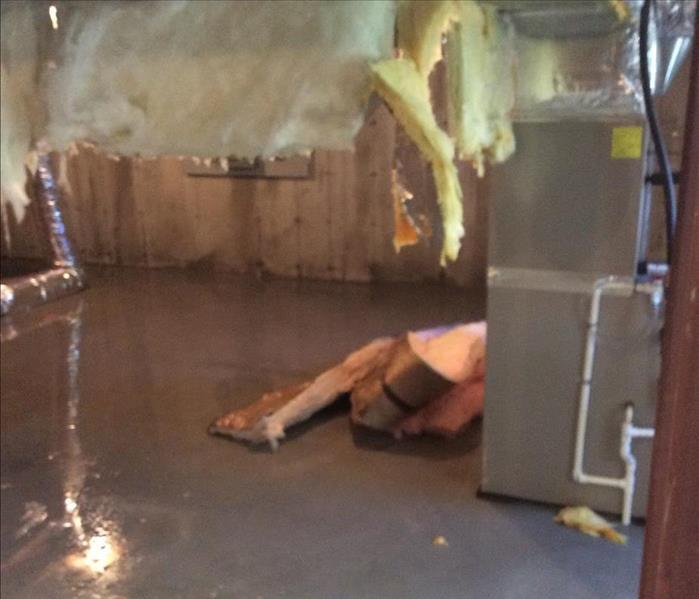 After the pipes froze and burst in this Bethany, CT home, the water flooded the basement.
After the pipes froze and burst in this Bethany, CT home, the water flooded the basement.
As a homeowner, you are at risk of experiencing water damage in your house.
This is true regardless of whether your house is old or new, big or small, in the country or in the city. From supply line leaks to bathtub overflows to frozen pipes, our water damage restoration team has seen it all here in New Haven County.
These are the most common causes of residential water damage that SERVPRO of Milford-Orange-Stratford responds to.
Water Heater Leaks
Usually located in the basement, a water heater leak can be an especially damaging event because it is not always immediately discovered. Water heater failures occur for a variety of reasons. Often, the leak is caused by a loose or faulty drain valve. Inspecting your heater’s valves and tightening them if needed is an easy way to avoid disaster. As water heaters age, they can corrode and rust, causing degradation to the tank. This can cause your water heater to leak and flood your basement.
Clogged Pipes
Clogged pipes can occur due to several reasons but the result is eventually the same- water damage. Keep a lookout for the signs of a clogged pipe such as reduced water pressure. Look for small leaks from your pipes as well as mildew, mold and water stains on walls. If water drains slowly in your sinks or shower, that is a sign that your pipes are partially clogged. If you hear gurgling sounds when there is no water running through your pipes, that may indicate a clogged sewer line. Educate your family on what items should be disposed of in your toilet to avoid a toilet clog. If you have a septic system, the regular use of enzymes in your toilet and shower drains can help keep them clear.
Household Appliance Malfunctions
We have seen water damage from all household appliances-especially refrigerators, dishwashers and washing machines. This can occur from a supply line leak – although the line is often small, the water that runs through it is unlimited. Supply lines can deteriorate and fail with age but we’ve even seen new lines break, so keep an eye behind your appliances for potential issues. Replacing rubber hoses with braided stainless steel ones will reduce your risk of a supply line leak. Washing machines can leak due to a water pump failure and broken door seals, gaskets and latches. Regular maintenance of your washing machine is recommended.
Frozen Pipes
In Connecticut, frozen pipes are a common event and keep our crews busy through the winter months. Pipes usually freeze because the home or area of a home such as a sunroom is inadequately heated. The pipes are forced to expand due to the frozen water, causing the pipe to crack. When the temperature warms up, the water flows freely through the cracks, causing massive damage. If you lose heat to your home due to a power outage during a snowstorm, feel your pipes to make sure they aren't freezing and use an alternative heat source if available.
Wet Basements
On the Connecticut shoreline, basements are inherently damp. They are prone to flooding, and are the home to pipes that may leak. If you have high levels of moisture in your basement, install a dehumidifier to dry it out. Make sure that the ground around your home is graded away to reduce flooding. Check your foundation for any cracks that may be allowing water in and seal them up. Broken gutters that are not properly directing the water away from the house can also contribute to basement flooding.
Sump Pump Failure
A sump pump can be a life saver if you have a wet basement but if it fails, you can have major water damage. If your sump pump fails to operate, whether due to a power failure, or malfunction, the groundwater level around the foundation can rise to the point that it flows up and out of the sump onto the basement floor. Take the time to inspect your sump part regularly and check your basement if you have a power outage.
Prompt action is the number one thing a homeowner can do if they have water damage. The sooner the restoration process begins, the less work that will need to be done. SERVPRO of Milford-Orange-Stratford is New Haven County’s water restoration experts. Our team is highly trained and experienced. Call our Woodbridge office at (203) 301-0500 if your home is flooded with water.
Don't Let Water Damage Ruin Your Summer Vacation
6/20/2018 (Permalink)
With summer here, many families in New Haven County are getting ready for their summer vacations. Whether that means a camping trip or a tropical island, you will most likely be leaving your home vacant while you are off having fun. When a home is left empty, it is particularly vulnerable to extensive water damage since the water is not immediately discovered. We have restored homes in which water damage originated from a pipe leak, a refrigerator line burst or a toilet overflowed while the homeowner was away on vacation. Because the water was able to flow for several days, or weeks, the damage was spread throughout the home. Rather than localized damage to a kitchen floor, the water had also saturated through the sub floor and the lower home level as well.
Before you leave for your summer vacation, we recommend that you take a few precautions to avoid water damage in your Milford home.
1. Prior to your trip, turn off all of the water sources in your home.
This only takes a few minutes and is the number one thing that you can do to minimize water damage if something does break while you are away.
Turn off your water at the main source, which is usually located in your basement. While you are down there, turn off the valves to your exterior faucets as well. Then, open your faucets and drain your water lines as well as your toilets. Turn off the valves at the sink, dishwasher and washing machine.
2. Inspect Your Hoses
Inspect any hoses that connect to major appliances such as washing machines, dishwashers and refrigerator ice-makers. Make sure there are no kinks; replace any old or damaged hoses.
3. Keep the weather out:
Check that all doors and windows are securely shut and locked. A rainstorm can do a lot of damage through a non-latched window.
4. Check your gutters:
Clear your gutters of any potential blockages and take the time to make sure that your downspouts are still moving water at least 10 ft. from the home.
5. Inspect your sump pump:
If you have a basement and if you have a sump pump make sure that it is in working order. The last thing you want to do is come home to find your basement flooded.
6. Fire prevention:
Unplug appliances and electronic devices.
Thoroughly check wood stoves and fireplaces to ensure that they are out.
7. Keep the temperature right:
Set your thermostat to a temperature closer to outside temps (warmer in the summer, cooler in the winter) but which still protects your plants, pets and furniture.
It's always a good idea to have a friend check on your Orange, CT home while you are away.
Make sure someone has your contact info and our number (203) 301-0500 in case there is water or fire damage while you are away.
This Spring, Inspect Your Gutters to Avoid a Flooded Basement
4/23/2018 (Permalink)
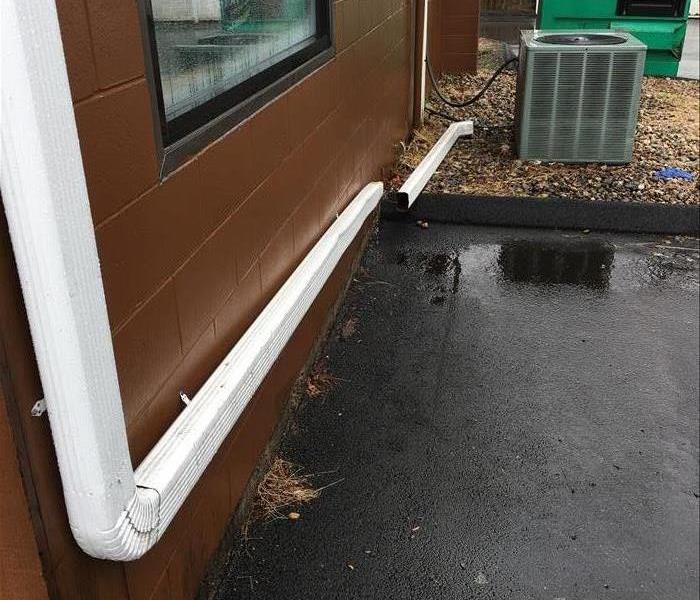 Something as simple as a broken gutter can cause serious flooding to your Wallingford, CT business during a rainstorm.
Something as simple as a broken gutter can cause serious flooding to your Wallingford, CT business during a rainstorm.
With all of the rain our area is having, we are currently restoring several homes and businesses that have water damage from basement flooding. We recently received a call from a business owner in the Meridan, CT area who had flooding in the basement of their commercial property. The cause of the flooding in this case was a broken gutter.
Gutters and downspouts play a vital role in keeping rainwater and melting snow directed away from a buildings foundation. If a gutter is clogged with leaves, is broken or has been misaligned, water can collect around athe foundation and make its way down into the basement. After a winter of high winds and heavy snow, it wouldn't be surprising if your businesses roof or gutters might have suffered damage. Take a quick walk around your building and make an inspection.
Make sure your gutters are clear of leaves and sticks. If blocked, the rain will fall over the edges and fall too close to the house. Also check to see if there are any breaks or damage to your gutters. Check that the downspouts have not been pulled away from the structure due to high winds this past winter. Keep the water flowing away from your house, which may require a gutter extension to direct the water even further away. It is recommended that your downspouts be ten feet away from your structure. A splashguard at the end of your downspout extension can also help the soil from eroding.
We also recommend that you inspect your foundation. Look for small holes or cracks through which water can enter. It doesn't take much water to cause substantial water damage.
The best time to conduct your inspection is directly after (or during) a rainstorm (if it is safe to do so!). You will be able to observe where water is puddling up and note any problem areas. If you see any water falling over the edge of your gutters while it is raining, there is a problem. If your gutters are in good working order and there are no blockages yet you see water collecting, it's possible that the area around your foundation requires grading to encourage the water to drain away from your building.
If you have concerns that you are at risk of flooding, check your insurance policy to see what it covers. Not all insurance policies cover flooding from groundwater. However, many insurance agencies offer optional coverage that offers protection from flooding caused by groundwater entering your home through the basement walls and foundation.
The longer water is allowed to remain in a flooded basement, the worse the secondary damage will be. If you have a flooded basement, contact SERVPRO of Milford-Orange-Stratford and let our team of experts help you out!
Ways to Prevent Water Damage From Washing Machine Leaks In Your Woodbridge Home
3/5/2018 (Permalink)
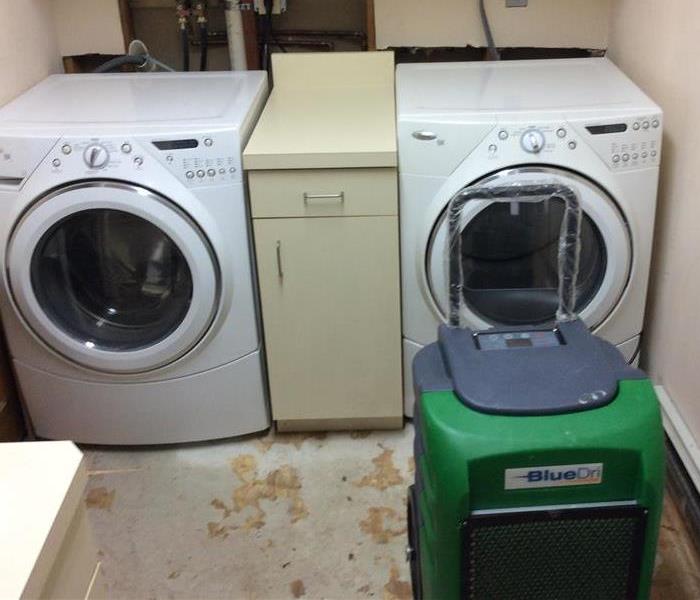 Whether from a burst hose or a failed pump valve, when washing machines malfunction they cause widespread water damage to Stratford area homes.
Whether from a burst hose or a failed pump valve, when washing machines malfunction they cause widespread water damage to Stratford area homes.
Most Connecticut households have a load of laundry going on a daily basis. The average life expectancy of a washing machine is 11 years and during that time, it endures 5,000 wash cycles. We put these appliances "through the wringer" - subjecting them to years of use without much thought about maintenance. It's no surprise that flooding from washing machines is a common cause of water damage to Milford homes.
Not only do washing machines malfunction often, the flooding that they cause tends to be very damaging due to the amount of water allowed to enter a home. A small crack in a hose can allow up to 250 gallons of water to enter your home in just a day. That's a lot of water working it's way through your home - in particular if you start a load and then leave for work, as many of us are apt to do. This can be especially damaging if you have a second floor laundry room.
There's no convincing any of us to give up our washing machines and go back to old fashioned washboards, so what can be done to protect a home from flooding? Having responded to dozens of homes with water damage from washer leaks over the years, the SERVPRO of Milford-Orange-Stratford team has identified a list of preventative measures that homeowners can take to reduce their risk of home flooding from washing machine malfunction.
- Check that your connectors have not loosened and are secured tightly – look for moisture, rust or dripping around the connections.
- Get rid of those old rubber hoses! If you have a rubber hose on your washing machine, replace it with a stainless steel hose – they cost under 20 dollars and will not crack, burst or wear out like rubber ones can.
- Give your washer a little breathing room. Keeping it 6" away from the wall can prevent your hose from kinking.
- Look for machine movement. Keep an eye on your machine's location- if it seems to drift to one side or forward, it may be imbalanced. This can also stress connections and hoses.
- Turn the water off. Get in the habit of turning off the water supply valve (usually located behind the machine) when you are leaving your home for an extended time.. It's a good idea to turn off your main water supply as well if going on vacation.
- Don't overload your washing machine as this can cause stress on the machine and connections.
- Inspect the pump valve to your washing machine to make sure there is no debris or blockages to the valve or it's filter. If blocked, the water cannot drain properly and will end up leaking out and onto (and through) your floors.
- If you really love having that upstairs laundry room because of the convenience, install a flood stopper in your laundry room. This device, which is placed on the floor near your washing machine, has a sensor that detects moisture. If it is triggered, it will automatically shut off the water supply! For about $150, you can have the peace of mind that if something does malfunction, your damage will be minimal.
Water damage of this type requires a clean up from a professional restoration company. The water may have seeped under the linoleum or carpeting and saturated the subfloor. Walls and ceilings of the lower levels may be wet from the floodwater and require removal. Proper water damage restoration will ensure that mold does not grow due to the home not being dried and sanitized properly. Fortunately, most homeowner's insurance policies cover water damage from appliance leaks. If your washing machine floods your home, call SERVPRO of Milford-Orange-Stratford at 203-301-0500. Our IICRC trained team will restore your home from start to finish, from the initial water extraction until the last piece of new baseboard is nailed down.
Tips To Help Prevent Pipes From Freezing:
1/4/2018 (Permalink)
Winter is in full effect! In an effort to help keep your pipes from freezing, consider the following tips:
Outdoor Care:
Disconnect all garden hoses and if there is water shut off valve, turn it off! Also, consider installing covers on exterior water supplies.
Prevent the water meter from freezing during cold weather by keeping it securely covered.
Indoor Care:
Identify the location of the main and water heater shut-off(s). Knowing the location of these valves can come in handy during an emergency and could help prevent further damages.
Be sure that your home’s thermostat is NOT below 60 degrees.
Leave cabinet doors below sinks open to allow heat from home to circulate.
Close all windows and seal any gaps open to the outside elements, especially those near water pipes. Freezing temperatures combined with wind drafts can cause pipes to freeze.
Insulate pipes that are near exterior walls or in unheated spaces of your home. This can prevent freezing, especially for interior pipes that may run along outside walls.
Seal leaks that allow cold air into your home by weather strip, caulking or insulating. Check air leaks around flue or chimney chase, electrical wiring, dryer vents and pipes. Also, consider insulating outside walls that are in unheated spaces of a home.
If away, shut off water supply valves to your washing machine.
Leave lukewarm water dripping slowly from faucets during extremely cold periods. Water moving through the system should prevent lines from freezing.
If a Pipe Bursts:
Shut off water at the main valve.
If the break is in a hot water pipe, the valve on top of water heater should also be turned off.
Call a plumber immediately! Then call SERVPRO of Milford-Orange-Stratford for immediate mitigation services.
With Colder Temperatures, Are Your Pipes at Risk?
1/4/2018 (Permalink)
As temperatures continue to drop, pipes are at risk of freezing, especially while families are traveling for the holidays.
Although pipes can freeze anywhere in your home, there are some areas that are more susceptible than others:
- Crawlspace- Many older homes in CT have a crawlspace rather than a full basement. They are typically not insulated and the pipes are exposed to the environment. Lining the sides of the space with foam board and the ground with plastic can help. You may also consider installing a heat cable that runs along the pipes and is turned on when the temperature drops.
- Under the Kitchen Sink- In particular, sinks that are on an exterior wall tend to experience frozen pipes. An easy solution to this is leaving your cabinet doors open to allow the warm air in the home to circulate.
- Bonus Rooms Above the Garage- Most bonus rooms are built above an unheated garage. They are exposed to the cold air (especially along the exterior walls). Keeping the temperature in your garage above freezing with the use of forced air heater unit for those frigid days can help.
When the unexpected happens, we can help restore your home quickly and thoroughly, call us at 203-301-0500.
High Humidity Effects
10/25/2017 (Permalink)
During a water damage to your home or business while some of your contents might not have been directly affected by the water, however the moisture in the air could have devastating and long lasting effects.
Clothing items, soft fabrics, and upholstered items exposed to high humidity are more likely to be ruined by mold and secondary damages. Besides microbial growth that can occur, high humidity from water damage can deflect, bend, or reshape these soft good items. High humidity will not distinguish between designer suits or an old pair of sweatpants, so realizing the problem and resolving it quickly is the best prevention to protect your content items.
Furniture covered with fabric has a lot of area for potential mold growth. When mold forms on upholstered furniture exposed to high humidity, repair can be very difficult or impossible. And who wants a smelly sofa?
While all of the conditions described above sound upsetting, they’re easily avoided. With Proper Water Mitigation and Drying. Here are SERVPRO of Milford-Orange-Stratford we are trained in how to respond when this type of damage occurs. Please check out our website for additional info about water damage and high humidity secondary damages. www.SERVPROofmilford.com
Ground Water Flooding due to recent storms
10/24/2017 (Permalink)
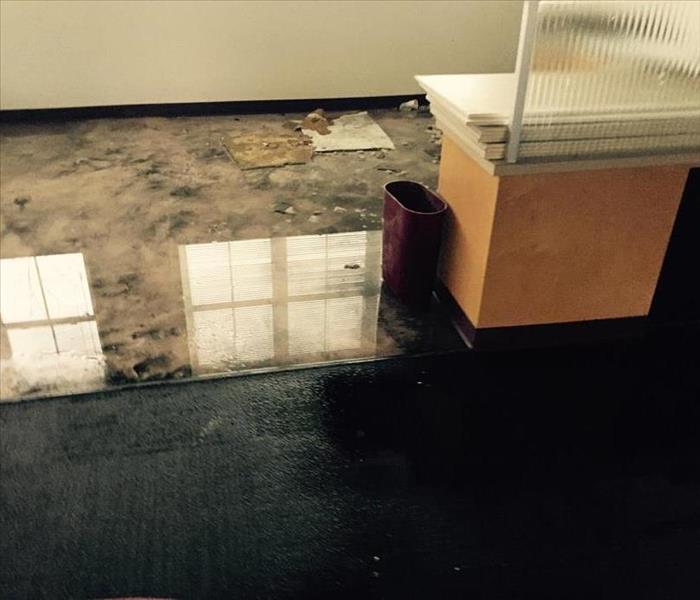 Flowing Groundwater with Unknown Contaminants
Flowing Groundwater with Unknown Contaminants
The fast moving rain and thunder storms that are running across CT on 10/24/17 from west to east are causing flash flooding to many homes and businesses in a widespread fashion. It is crucial for homeowners and business owners to deal with ground water entering their properties in an immediate fashion.
Groundwater can carry unknown contaminants that can travel with the rain water that passes through the soil and pickup potential pesticides and other unknown contaminants and deposit them in your affected areas. For example, Beryllium, naturally occurs in soil and groundwater. To learn more about the effects of Beryllium from water damage, please follow this link for more information https://water.usgs.gov/edu/groundwater-contaminants.html
If you happen to experience water damage to your home or business, we are available to assist in the proper removal and water restoration 24/7 and 365 days a year to your property. For additional tips and info and contact information please click on our website at www.SERVPROofmilford.com
SERVPRO of Milford-Orange-Stratford is an IICRC certified firm that specializes in water damage restoration.
Clean your Gutters!
9/26/2017 (Permalink)
To help minimize potential exterior/interior, water issues be sure to clean your gutters and drains to ensure that water is properly draining from your home or building.
Our office is commonly flooded with phone calls during the fall due to backed up gutters and drains that enter a home or business and cause water damage. The backing up of gutters is very common due to the simple fact that leaves, acorns, and other debris build up in the gutters and rain water has no where to go but into your home.
This same type of debris indicated above can cover up drains along foundations and patios which will lead to water damage to basements and lower levels of your home. Not only can water damage occur to your interior living space, but the even more costly damage can take place such as foundation damage, peeling paint, rot to sill plates, and other costly items.
Simply put an ounce of prevention will lead to pounds of protection by just maintaining the water drainage system designed to protect your house or building.
If water damage does occur to your home it is imperative to address it immediately. We are available to help 24/7 at SERVPRO of Milford-Orange-Stratford. www.SERVPROofmilford.com
Signs That Your Hot Water Tank Could be Failing You!
7/9/2017 (Permalink)
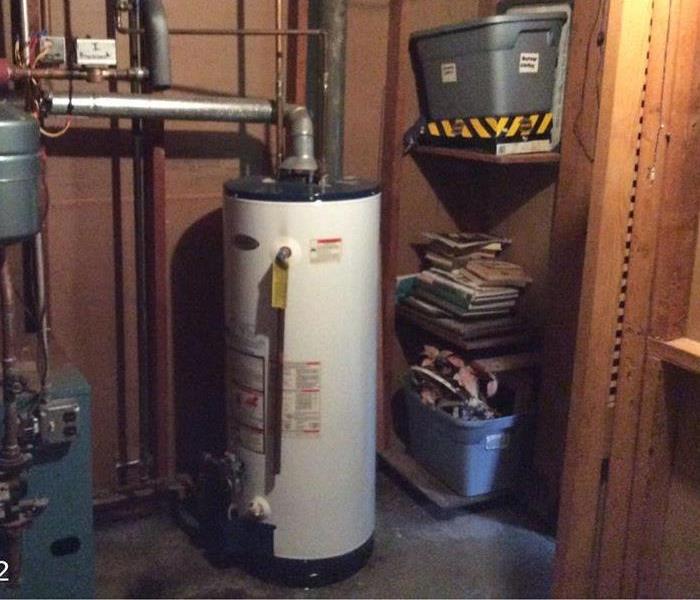 Hot water storage tank
Hot water storage tank
Signs That Your Hot Water Tank Could Be Failing You!
The average hot water heater lasts approximately 10 years before it needs to be replaced. Internal parts of the heater can corrode or over time, develop mineral buildup. Mineral buildup can compromise the efficiency of the heater. Regular flushing and professional annual maintenance can help prolong the life span of the unit. To avoid any disruption or damage of a failing water heater. Below are indicators that your water heater may be in need of repair and/or replacement.
Common signs to look for:
- Insufficient water
- Noisy water heater
- Cloudy or hot water that may have an odor
- Metallic water taste
- Rust or leaks around connections
- Leaking tank
If you are experiencing any of the above signs, have it serviced immediately!
Did You Know That There Are 3 Categories and Classes of Water Contamination?
5/22/2017 (Permalink)
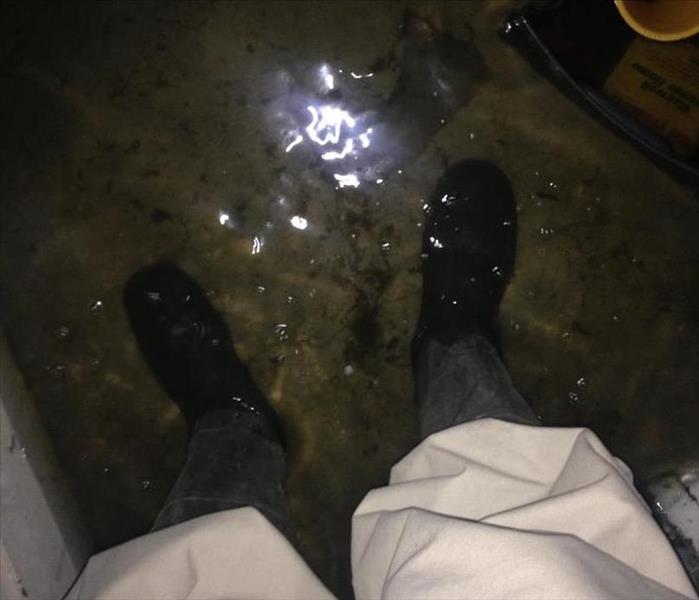 Category 3 - Ground Water
Category 3 - Ground Water
With all the recent rain fall, did you know that there are different categories and classes which describe contaminated water? According to the IICRC (Institute of Inspection Cleaning and Restoration Certification), which sets the standards for the cleaning industry and water damage restoration training, there are several different levels and classes around water destruction. From the IICRC’s S-500 standards, they are as follows:
Category 1. This is water from a clean and sanitary source, such as broken water supply lines, tub or sink overflows or appliance malfunctions that involves water supply lines. The cleanliness of Category 1 water can deteriorate quickly due to contact with building and other materials.
Category 2. This category, once referred to as grey water, contains level of contaminates that may cause illness or discomfort if ingested. Sources include toilet bowls with urine (no feces), sump pump failures, and water discharge from dishwashers or washing machines.
Category 3. This is the worst classification, once referred to as black water, is grossly contaminated and can contain pathogenic, toxigenic, or other harmful agents. If ingested it can cause severe illness or death. Sources include sewer backup, flooding from rivers or streams, toilet overflow with feces, and ground surface water or standing water that has begun to support bacterial growth.
Next are the classes of water damage which determine the probable rate of evaporation based on the type of materials affected, or wet, in the room or space that was flooded.
Class 1. Slow rate of evaporation and easiest to deal with. Only part of a room or area was affected, there is little or no wet materials, and the moisture has only affected materials with a low permeance rate, such as plywood or concrete.
Class 2. With a fast evaporation rate, this level affects an entire room, carpeting, or cushioning, the wetness has wicked up the walls at least 12”, and there is moisture remaining in structural materials.
Class 3. This class has the fastest evaporation rate. Ceilings, walls, insulation, carpet and sub-floors are all saturated.
Class 4. This class is labeled as specialty drying situations, which means there has been enough water and time to saturate materials with very low permeance, such as hardwood, concrete, stone, crawlspaces and plaster.
Should the unexpected happen and you are faced with a water loss, please call us at 203-301-0500. We make it “Like it never even happened.®”





 24/7 Emergency Service
24/7 Emergency Service
